Part 5 -
Breakthrough!!
Story written by Rick Archer
|
 |
Dawson, Streczyk and Spalding
|
The
Americans were pinned down on the beach. If someone didn't do
something, they weren't going anywhere but to their graves.
However, everyone was too paralyzed with fear and shock to move.
Deeply traumatized by the horror of the Omaha bloodbath, these men
had never been more frightened in their lives. Oh sure,
'courage is ability to act in spite of fear'.
When you have just seen your best friend's head ripped off by a
mortar shell and your Captain is lying dead on the beach with his
guts hanging out and the guy next to you is screaming for you to
shoot him because of the agony he is in, you go into shock.
Shock is a state of self-preservation. It is the mind's way of
saying that to move invites almost certain death. The state of
shock is beyond rational. An overwhelming fear takes control
and prevents any conscious thought from occurring. It isn't
like those men were hiding behind the shingle wall saying, "Well,
should I get up and attack?"
Nonsense. They were frozen. They were numb, mindless,
dispirited zombies. They were afraid for their lives and they
weren't moving.
|
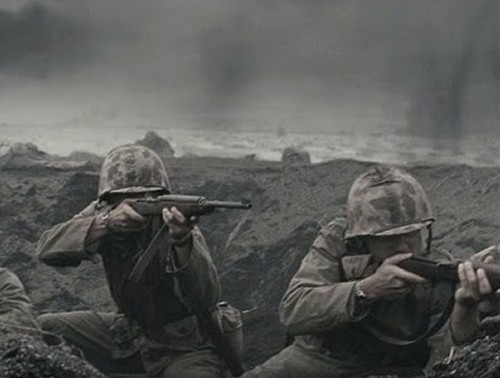 |
| |
|
The 5-mile sector of beach that the Allies had code-named
Omaha was lined with rolling hills and cliffs.
There were five major gaps, or "draws", between those hills.
Steep bluffs ranging from 100 to 150 feet high dominated the
entire beach. These bluffs were divided into
different sections by five small wooded valleys known as
"draws" along the beach. These five draws were
codenamed D-1, D-3, E-1, E-3 and F-1.
The
main purpose of the assault at Omaha Beach was to gain possession of
a "Draw", the military term for these openings between the hills.
The
American tanks could not go up the hills and bluffs, but they could
go through the Draws. Therefore a
premium was placed on gaining control of the Draws so the
Americans could get their tanks rolling into open country
towards Caen and Cherbourg.
Defending the draws
were German strong points known as the
WNs
(short for
WiderstandsNest). The
battle of the day revolved around knocking out these powerful German
WN
defensive strong points
Unfortunately the
Germans were determined to protect those gaps at all cost.
The Germans wanted to keep the American tanks on the beach where
they could destroy them with their powerful artillery guns.
With WNs
positioned on either side of every draw, the Allies were determined
to knock out the
WNs so their tanks could get through.
The Germans were just as determined to stop that from happening.
American tanks could not be allowed to enter the French countryside
where they would wreak havoc.
|
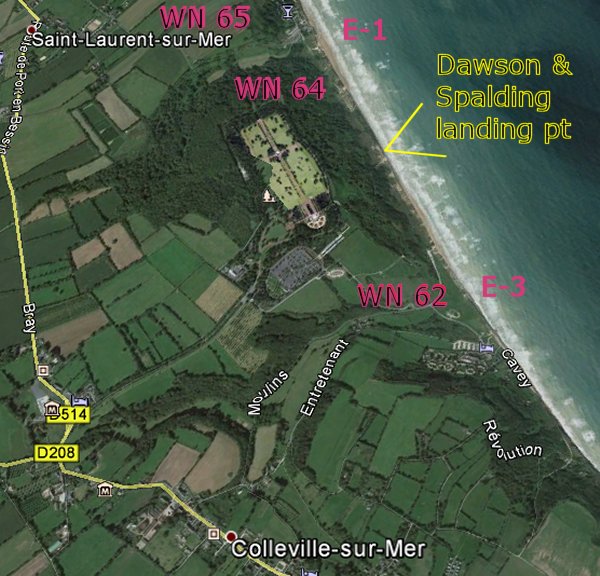 |
|
|
|
|
|
|
|
|
|
|
|
The Germans had a counter-attack strategy in play. The defenders expected that Captain Bronikowski's feared 21st Panzer
Division was headed towards them to join the fight late in the day.
If they could just hold on, the Panzers would be there soon to kick the Yanks
back
into
the sea.
The Germans had all the advantages. They had the high ground,
they had fortifications, they had trenches, they had every
possible sector crisscrossed with fire, and they had mine fields and
barbed wire as well to protect their lofty positions. With
this kind of leverage, one machine gun could keep 100 men frozen on
the beach all day long.
As D-Day began, Rommel's strategy was working to perfection - keep
the men on the beach. As long as they stayed on the beach, a
bullet would find them eventually.
Unless the Americans could
knock out some of those guns, the German
strong points would continue the slaughter until the last man on that
beach was dead. Someone had to get to those guns and silence
them! But how?
To leave the sea wall invited instant death.
Of all the Draws, E-3, the opening which led to
Colleville-sur-mer (Colleville by the sea), was the most
tempting.
This draw was nearly 600 yards wide with only
WN62
standing in the way. The American strategists decided to
concentrate their attack on this point of the beach.
This would become one of the worst decisions of the day.
|
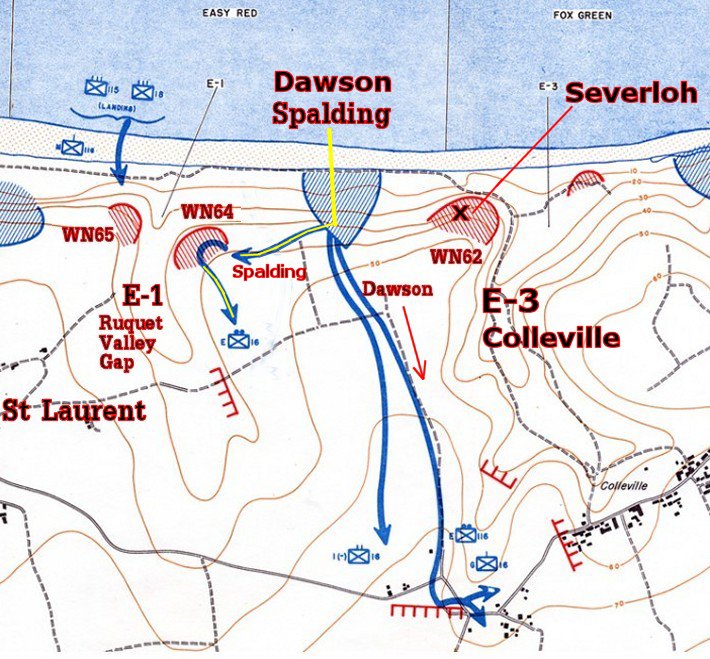 |
| |
|
1,000
Americans were killed in front of strong point
WN62.
Of the men that died, Heinrich Severloh, the Butcher of
Omaha, was responsible for most of those deaths.
Severloh manned a machine gun with an unobstructed view of
the entire beach. With nowhere to find cover, 1,000
helpless GIs died under his withering fire.
The men who created the amazing Breakthrough were Company E led by Lt
John Spalding and Sgt Phil Streczyk, and Company G led by Captain
Joseph Dawson. These two companies had the good fortune
to land just a few yards beyond the reach of Severloh's machine gun
15 minutes apart.
Captain Dawson's company arrived second. Dawson was supposed
to attack
WN62, but
all it took was one look at all the dead bodies to change his mind.
Instead Dawson decided to take his chances with the gully right in
front of his landing point. About halfway up, Dawson's
company met Spalding's company. Ordering everyone to stay put,
Dawson then proceed forward by himself. What he did from there
was amazing...
|
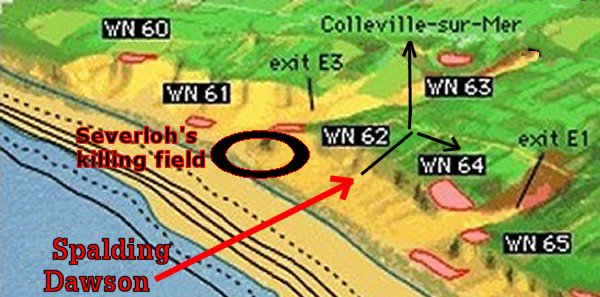
After the Breakthrough, Dawson
and
Spalding's companies met
at the top of the Bluff. Dawson's men went on to
Colleville
while Spalding's men turned right in search of WN64 |
|
|
Excerpts on
John Spalding and Philip Streczyk from the
War Chronicle
Rick Archer's note: One thing to always keep in mind as
you read this remarkable story is that I have consistently borrowed
from the hard work of other men to tell this story. Some
of the material is from newspaper clippings, military archives, and
public records while other material was taken from some of the
excellent books written about D-Day. In addition I have
visited some wonderful web sites like the War Chronicle that are
dedicated to honoring the memories of the soldiers who fought that
day... including the many men who gave their lives in the process.
Therefore, I freely admit my own account of the events of D-Day
rests completely on the shoulders of other fine people who - like me
- want the world to remember the accomplishments of the young men
who risked their lives for American freedom.
I have no idea of the identity of the person who created the "War
Chronicle" web site... he seems to prefer anonymity... but I would
like to acknowledge his (or her) immense contribution to our history
of D-Day. You cannot imagine the wealth of information
contained on the War Chronicle web site. I hope this
individual does not mind that I have borrowed heavily from his (or
her) work.
I assume this gifted historian will understand that my motives are
the same as his - the story of D-Day needs to be shared with as many
people as possible.
|
|
|
Lt.
John Spalding
(from the War
Chronicle)
Before our country was at war, while Europe was in flames, the
United States hastily began building an Army. In October of 1940,
all males from the ages of 21 through 35 were required to register
for possible military service. At local draft boards, men who passed
the exams were given a number. Thousands across American had the
same number, and they were drafted when it was picked out of a glass
tank in Washington, D.C.
Sixteen million men registered. A million of them were drafted. John
Spalding wasn’t one of them, but he joined the Army anyway. He
kissed his wife and young son goodbye, and left his home in
Owensboro, Kentucky. Ten months later, the Japanese attacked Pearl
Harbor, Hawaii. Soon Japan, Germany, and Italy had all declared war on
the United States. The Second World War, as a global conflict, had
begun.
Germany was America’s strongest enemy and America was their weakest
opponent. America needed years to amass and train enough soldiers
for a direct attack on the Nazi heartland. John Spalding spent those
years far from the frontline as part of the great build-up.
Meanwhile, combat soldiers of the 1st Division, the Big Red One, helped stop Nazi
aggression by invading two continents, first Africa, then Europe via
Italy.
The first D-Day
was the invasion of North Africa on 7 November 1942. Then came the
invasion of Sicily on in July 1943. Starting in the fall of 1943, the 1st
Division was secretly shipped from Sicily to England to join the
gathering forces. No one explained the next mission. No need
to. Despite the secrecy, the soldiers knew in their
bones that the big one was next. Fresh troops joined the division as
reinforcements and replacements for soldiers killed in action.
One of those new men was Lt. John Spalding (the younger man pictured on the right).
Spalding was
appointed the commanding officer of the 1st Section just
shortly before the eve of D-Day. For him, the war was about to
begin. On the night before D-Day, Spalding's commander, Capt.
Ed Wozenski, gave his men a final briefing. Their mission was to
destroy a German strong point on top of a hill overlooking Omaha
Beach.
|
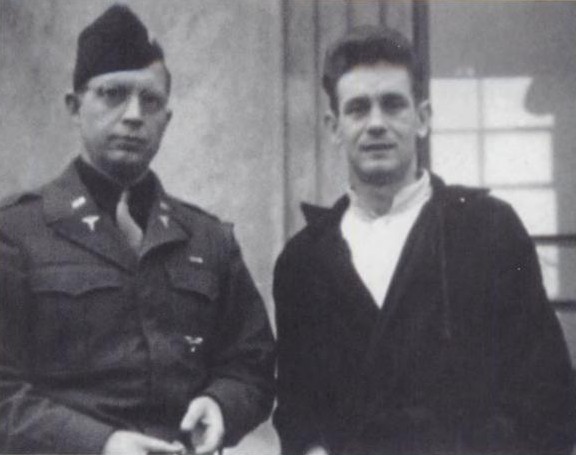 |
|
Sgt. Phil Streczyk
(from the War
Chronicle)
Phil Streczyk was a warrior: the most daring fighter his men and
officers ever knew.
He was born near East Brunswick, New Jersey. Streczyk was one of ten
children. Like many kids during the Great Depression, Streczyk worked
full time from an early age. He dropped out of school after the 8th
grade to earn money and help his family. One might assume
given his background that he was a tough kid.
By the time Streczyk was 21, he was a truck driver. Then his draft
number was picked. After months of training, he was shipped
overseas. In Tunisia, North Africa, Streczyk won his first of many
medals. His men were trapped and Streczyk risked his life by
crossing into the open and attacking the enemy with grenades. He
took out two enemy guns in the process. For his courage, Streczyk was awarded
the Silver Star. He mailed it home to his mom.
Although he was extremely popular, Streczyk sometimes scared his own
men as much as he scared the enemy.
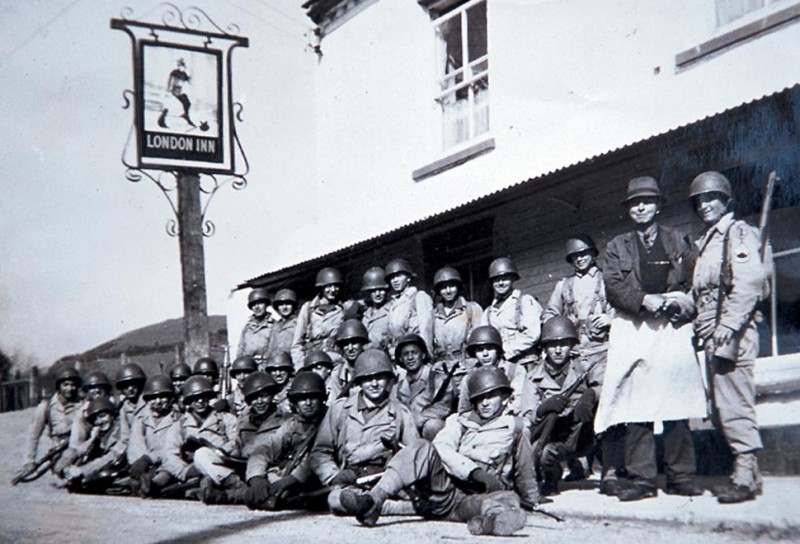 |
“One
time in Africa,” Clarence Colson remembers, “Streczyk got hold of a
German motorcycle, and he came riding that thing like a wild man.
Maybe he figured the Good Lord was watching over him, but he just
didn’t seem to care.
We had an awful time keeping a helmet on him. When someone would
start shooting at us, everyone would keep their heads down, taking
little peeks out of the foxholes. Not Streczyk. He would be popping up like
a robin.”
When the 1st
Division reorganized in England, soldiers were shuffled into 32-man
sections so that a team could fit in one small landing craft.
Sgt. Streczyk
was second-in-command. The new men listened carefully to everything
the sergeant said. He was brave and, more importantly, he knew how
to keep them alive. (Streczyk is the one shaking hands)
|
|
|
|
Captain Joe
Dawson
Joseph T Dawson was an officer in the U.S. 1st Infantry Division during
World War II. He was the third child of Baptist clergyman
Joseph Martin Dawson and Willie Turner Dawson. He was born in
Temple, TX, in 1914. His father was the
minister of the First Baptist Church in Waco, TX.
Dawson was a 1933 graduate of Baylor University.
Dawson enlisted in 1941 as a private and fought earlier campaigns in
Africa and Sicily. Before D-Day, Dawson served as a staff officer in
the First Division and the 16th Regiment during the campaigns in
North Africa and Sicily. He served well and worked his way up
in rank. Shortly before D-Day, Dawson was promoted to Captain.
Dawson landed
at Omaha Beach with the 1st Infantry Division -- "The Big
Red One". Before the day was over, Dawson, 30, would
be credited for spotting the first path off of the beach.
By the end of the day, Dawson's troops were the farthest
inland of all the Americans.
|
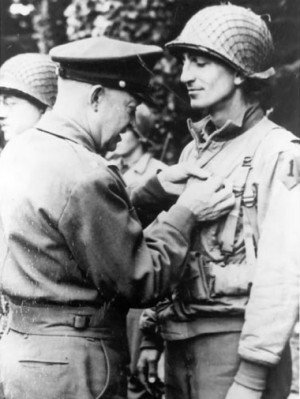 |
|
|
|
|
The Story of Spalding, Streczyk, and E Company
Rick Archer's Note:
In 1945, eight months after D-Day,
John Spalding (sometimes spelled 'Spaulding') was formally interviewed regarding his role at Omaha
Beach on D-Day. For the following part of the story
about Spalding's E Company, I used
several excerpts. Please be aware that I have paraphrased Spalding's report
in several places.
I did not change a single incident, but I did try to make his dry
military report a bit more readable. You may read Spalding's
original (and unedited) oral history
here. In addition, I added comments from
several of the members of his Company E who participated.
Okay, folks, put on your seat belts;
here we go.
You are about to read one heck of an amazing story.
|
|
|
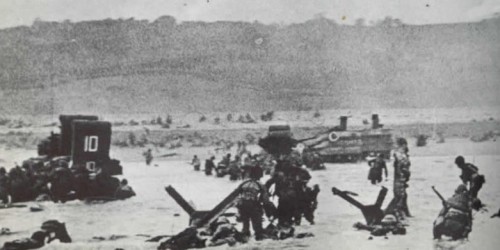
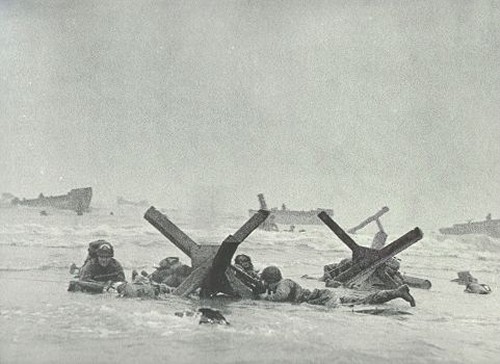 |
Lt John Spalding's Narration:
"When we got 200
yards offshore the boat halted and a member of the navy crew yelled
for us to drop the ramp. Sgt Bisco and I kicked the ramp down.
We had come in at low tide
and the obstacles were noticeable. They stuck out of the water and
we could see teller mines on many of them. No path had been cleared
through them, so we followed a zigzag course in. It is difficult to
know if the navy could have taken the boats in further. It is
possible that they would have stuck on the sand bars. I am in no
position to know whether the boats could have done any better.
Because we were carrying so much equipment and because I was afraid
that we were being landed in deep water, I told the men not to
jump out until after I had tested the water. I jumped out of the
boat slightly to the left of the ramp into water about waist deep.
It was about 0645 (6:45 am). Then the men began to follow me. We headed ashore
and the small arms fire became noticeable.
As we left the boat, we spread out in a V formation about 30 yards
across. There was soon a noticeable decline of sand beneath our feet.
We were soon over our heads, so we tried to swim. Fortunately
when I pulled the valve of my lifebelt it inflated and saved me. I
lost my carbine. We lost none of our men, but only because they
helped each other or because they got rid of their equipment.
There was a strong
undercurrent carrying us to the left. I had experience with the
strong current of the Ohio River as a swimmer, but this was much
stronger. Sgt. Streczyk and the medic—Pvt. George Bowen—were
carrying an 18 foot ladder which was to be used for crossing the
anti-tank ditch or scaling a steep ridge. They were
struggling with the ladder in the water just about time that I was having my
worst trouble staying afloat. As the ladder came by me, I grabbed it.
|
Streczyk yelled and
said "Hey, thanks, Lieutenant, but we don't need any help!"
Hell, I was busy
trying to get some help, not to give it! Once I regained
my balance, I told them to leave the damn ladder behind.
About this time we were able to put down our feet and touch
bottom; the water was up to our mouths. I had
swallowed about half of the ocean and felt like I was going to
choke to death.
I wasn't the only
one.
We pulled out
Sgt. Edwin Piasecki who was about to drown.
About this time Pfc. Vincent DiGaetano, who was carrying a 72
pound flame thrower, yelled and said, "I'm drowning, what do you
want me to do with this flamethrower?" Streczyk told
him to drop it, so he did. Then Streczyk changed his mind
and told DiGaetano to go back and get it. It's a good thing he
went back, that flame thrower came in very handy later on.
In addition to
losing many personal weapons, we lost our mortar
and
most of the ammunition, one of our bazookas and much of the
bazooka ammunition. However, I noticed the men who kept their weapons were able to fire them as
soon as they came ashore. It shows that the M-1 is an excellent
weapon.
Our first casualty
came at the water's edge. Pvt. William Roper was hit in the foot
by small arms fire just as he hit the beach. He kept trying to
get his legging off, but couldn't reach the lacing, so I helped
him get it off.
Just after we got
ashore one of my two BAR men was hit.
Pfc. Virgil Tilley was hit in the right shoulder by a shell
fragment, which drove a hunk of the shoulder out towards the
back but did not come all the way through.
I
noticed a number of my men on the beach were all standing up and
moving across the sand at a steady pace. They were too waterlogged to run, but
they went as fast as they could. It looked as if they were
walking in the face of a real strong wind. We moved on across
the shale to a house which was straight inland.
The first place we stopped was at a demolished building; there was
some brush around. The building had a concrete wall we could
hide behind. Why the Germans allowed even a single part of this
structure to stand made no sense, but I was glad it was there.
My section was spread out—the men in accordance with orders had
deployed the minute they hit the beach. They had been told to
get off the beach as soon as possible. We were halted there by
barbed wire at the first slope.
They walked on across
because nobody stopped them. I was curious why there was no MG
(machine gun) fire to speak of. Someone pointed out a
pillbox on the hill facing us that didn't seem to be in
operation. It doesn't hurt to be lucky."
Sgt Clarence Colson's Narration: "But then there was a
path. When I looked and seen that path...there was this pillbox
way over here that wasn’t manned. They didn’t have nobody manning
that pillbox.
I couldn't believe it. They didn’t have
nobody manning that pillbox. What the hell. Enemy
fire was all coming from this other direction, but not from that
pillbox. Why wasn't anyone in there?"
Lt John Spalding's Narration:
"I
didn't see any mines on the beach except Anti-Tank mines.
Down near the water's edge we ran into wire. S/Sgt. Curtis
Colwell blew a hole in the wire with a bangalore. We picked our
way through; I personally didn't see the gap he had blown, but I
was still in a daze."
|
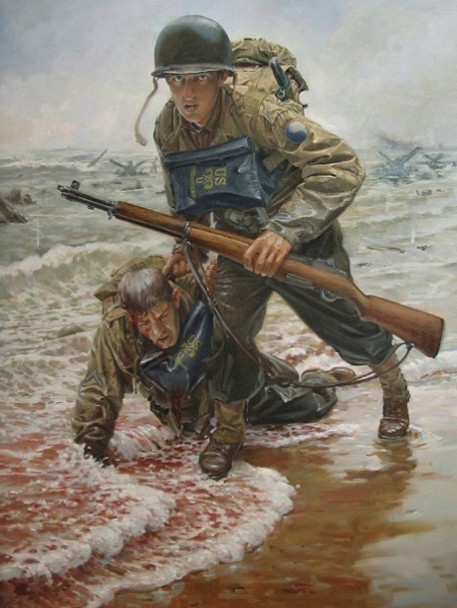
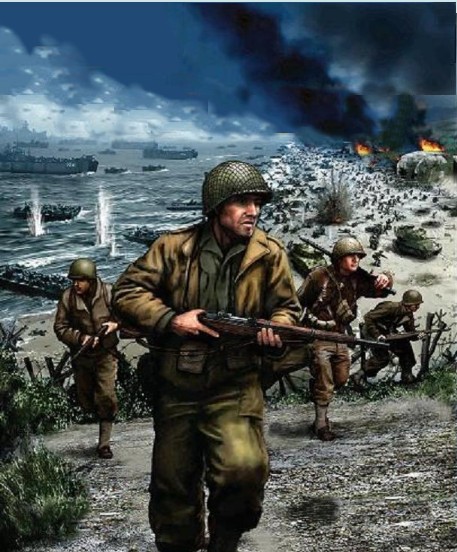 |
|
|
The Story of Joe Dawson and G Company
Rick Archer's Note: Now we turn to Capt Joseph Dawson's story.
Please be aware that in places I have paraphrased Dawson's story
for brevity.
(Note: The following excerpt comes from
Joseph Dawson's book, From Omaha Beach to
Dawson's Ridge, pg 148-150)
Captain Ed Wozenski, who commanded Spalding's E Company,
remembered,
"Men were
falling on all sides and the water was reddened with their
blood. The survivors still moved forward and eventually
worked up to a pile of shale at the high water mark.
Unfortunately, most of our guns were
jammed with sand, but every
rifle that worked was brought to bear on the enemy.
Men armed with no more than pistols were firing at machine
guns in an effort to cover the men still struggling to get
ashore."
Enemy snipers mercilessly mowed down anyone attempting to
return to the water and drag their wounded comrades to the
base of the shale. By the time Wozenski's men reached the
summit later in the morning, a rough check revealed that
well over one hundred men of the 183 who landed were killed,
wounded, or missing. So much for
Patton's promise of a 2% casualty rate.
"Utter chaos reigned,"
Joe Dawson recalled, "because the Germans
controlled the field of fire completely. The first wave was
totally disorganized by their tremendous number of
casualties."
Most of the first wave lay dead or dying, with their bodies,
equipment and the wreckage of battle clogging the shoreline.
The initial wave had become pinned down "mentally if not
physically," Dawson remembered. "There was no coordinated
fire from the Americans ashore. They were bunched shoulder
to shoulder and huddling on whatever patch of ground gave
them partial cover from the enemy fire."
Dawson realized some of these men were remnants of
Wozenski's E Company who had landed on the wrong beach and
had become demoralized. The inferno of Omaha consumed
everyone and everything that touched its shore.
Landing under
extremely heavy fire in his designated zone on Easy Red,
Dawson was the first man off his landing craft, followed by
his communications sergeant and his company clerk.
Ordinarily it was the first man off the boat who took the
first hit, but this time things were reversed. Just as
Dawson jumped, an artillery shell struck the boat, wiping
out the remaining 33 members of his headquarters platoon. This included the naval officer who was the fire control
officer assigned to coordinate the fire from ships offshore.
His loss would result in further tragedy later in the day.
Dawson had missed death himself by an instant. As the
men
said all day long, some people are born lucky. No one
who survived that beach landing ever doubted the possibility
of a guardian angel.
Within seconds, soldiers from the company's five remaining
assault crafts landed. The boats were hurriedly emptied, the
men jumping into water that was shoulder deep all the while
taking intense
machine gun and anti-tank fire.
Fortunately the division's initial assault wave had reduced a
number of beach defenses in G Company's zone, but enemy fire
remained heavy. Remarkably, other than the bad
shelling of Dawson's boat, most of Dawson's 219
men survived the initial landing intact. G Company then suffered
63 casualties as the men attempted to crawl or run from the
waterline to the shingle mound 5-10 feet high.
Once they were at the sea wall, finally
the company had a chance to regroup.
Overwhelmed by the sheer horror of the spectacle, Dawson
took command of all survivors who huddled in fear at the
sandbar whether they were in his company or not. Dawson realized, "There was nothing I could do on
the beach except die. I knew no one else was going to do it
for me. Some things one does automatically, some by circumstance,
but I knew it had to be done. There is no other way to say
it."
Looking back, Dawson said leading his men off the beach was
the toughest decision he ever made as a company commander.
He had no idea what their chances were once they left the
relative safety of the sea wall. It upset him to know he
might be leading men to their death. "I was fortunate enough
to realize that there wasn't any point in me standing there
and, frankly, I felt the only way I could move was forward.
I certainly couldn't go backwards. I chose to go up and see if I could get off the beach."
Dawson found a sergeant and two soldiers who refused to
advance. Dawson exhorted them to follow him, but they just
stared at him. Dawson kept moving
when they refused to acknowledge him, figuring they would
move soon enough if he didn't hassle them. Looking back over his
shoulder, he saw the trio still huddled behind a beach
obstacle. Angered, Dawson returned to confront the men
when he suddenly realized all three of them were dead. This
strange encounter reaffirmed his decision to get off the
beach. There might indeed be death waiting for them up ahead, but there was
only death waiting for the men who stayed here.
Those three dead men
bothered him more than he cared to admit. Dawson made
a fateful decision. He couldn't bear the thought of doing
something stupid and getting more men killed. He would
rather go himself with three other men, but leave most of
the men behind till he could ascertain what kind of danger
they would be looking at on that hill.
Dawson peeked
over the sand dune. There was no fire at the moment. He
decided to go. He discovered a mine field
immediately behind the shingle.
Dawson: "We dropped
over that sand bar and got into this minefield. And there was a
body of a boy who had found the minefield and unfortunately
also found the mine and destroyed himself, but he pointed
the way for us to go across him, which we did. Now
Sergeant Cleff and myself and Baldridge, plus another man in
my company, started up the hill.
As I can recall, I think the beach at Normandy was a
very unusual beach in that it came down from a great height
of over 250 yards in a sloped manner until it reached the
beach water. I stared up there and the ridge was a
long way away, but there didn't seem to be much at the top
where I was. The main defense of the Germans was
closer
right halfway up the slope overlooking the beach.
These were pillboxes that were encased in an area just beyond the beach.
Their strategy seemed to be all or nothing. Once we
got past the beach, we encountered very little gunfire on
our way to the top.
I found this path….it seemed to generally go in the right
direction toward the crest of the hill, and so I started up
that way.
And about half way there I caught up to Lieutenant Spaulding
with a remnant of his platoon. I think he had two squads and
a person in a third squad. They were the only survivors
that I knew of E company at that time. Meanwhile my
own men were still on the beach waiting for my orders.
Spalding decided to head to the right and I said I would
hang to the left.
I figured it was safe
enough, so I told Baldridge to go
back and bring the men up. I said, “They’ve got to get off
the beach. Tell them to come up here with me.” I was
up there alone now. Well, I decided not to wait,
so I climbed some more. I had no idea what was on top
of that hill. I couldn't see any defense up there, but
then I had a bad angle. Finally I reached a point
where it would not be safe to continue. Just before
you reach the crest of the ridge, it becomes almost vertical
for about a 10-foot drop. In other words, whatever was
on top I couldn't see them... and they couldn't see me either.
And there was
a log there. So I got behind the log to wait and see if I
could spot my men coming up."
|
|
|
Omaha Beachhead - Assault on the Bluffs
Rick
Archer's Note: Now that you have begun the story of Spalding and Dawson,
I think maps and some background information will help the
reader understand what comes next. Much of the following write-up is taken
directly from
John's Military History, an invaluable resource
created by John Hamill. I am in Mr. Hamill's debt for clarifying the route taken by Spalding to the top.
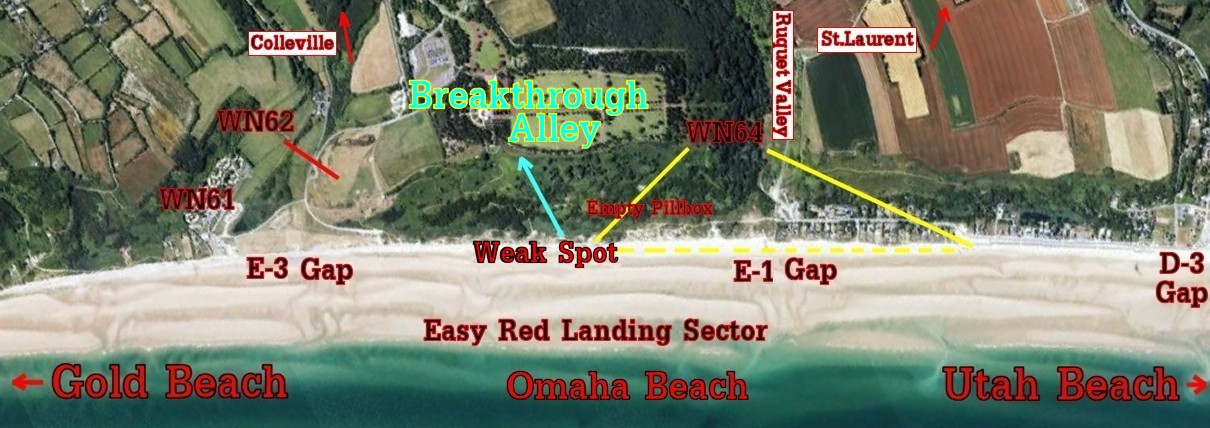
To better
understand how Spalding's men and Dawson's men were able to succeed
on D-Day, this map should help.
With the benefit of
hindsight, we see that Spalding's Company E has caught four enormous
breaks.
•
1. Company E landed in the weak spot where neither WN62 or
WN64 had a machine gun that could reach them.
•
2. A dangerous pillbox with a commanding position overlooking
the beach is mysteriously unoccupied.
•
3. Amazingly, they found a demolished building that afforded
cover from the small arms fire in the area so they could regroup.
•
4. Much of the 4-mile stretch of Omaha Beach featured steep
hills or cliffs. Not the Weak Spot... it was an easy climb.
•
5. The Germans had only one line of defense. Once
Dawson and Spalding got off the beach, their chances improved
considerably.
Unlike most of the Americans on Omaha Beach, Company E is clearly
operating under a lucky star.
Break #1
The light blue line marks the
Breakthrough Alley that Spalding and Dawson used on their
climb. Both Spalding and Dawson had the good
fortune of landing in the weak spot area above.
They hit the beach halfway
between the WN 62
and
WN 64 strong points.
Those strong points were built 1,300 yards apart. The range of
their guns was 600-700 yards. The weak spot was at the
extreme end of the range of its guns.
WN 62
and WN 64 were so far away from the Weak Spot that
their guns could
barely reach it.
I might add anyone landing at the mid-point would appear no larger
than ants to anyone at
WN 62
or WN 64.
WN 64
was a little farther away than the other strong point. The yellow
lines indicate the likely range of its guns. I am skeptical its guns could
even reach
the weak spot.
Break #2
In addition to their
good fortune of landing in an area relatively safe from the
dangerous strong points, Dawson and Spalding appear to have caught
yet one more incredible break when they encountered an unmanned
pillbox.
I came across an observation that hints
that one of the nearby beach pillboxes was not functioning.
Clarence
Colson, a member of E Company, said in his
oral history that a menacing pillbox near the area where he landed was
completely unmanned.
"Of
course
they were firing, but there was one pillbox way
over and there was nothing coming from that."
Spalding made a
statement in his interview that lends further credence to the
possibility that this particular spot was poorly defended:
"We
headed ashore and the small arms fire became noticeable."
Small arms fire? Where were the machine gun nests
manning this spot?
"They
were too waterlogged to run, but they went as fast as they could."
On other parts of the
beach, men had to crawl to get to the wall. But these men
staggered upright. This narrative is yet
another hint that the spray of bullets could not possibly have been
intense. Spalding notes only two injuries - a man shot in the
foot by small arms fire and a shoulder injury from an artillery
shell. But where was the machine gun spray? With men plodding across the beach upright as Spalding
indicates, they would have been sitting ducks. Any nearby machine gun would have inflicted a vast number of
casualties.
This comment about the two injuries is an indirect
confirmation that the men did indeed only face limited small arms fire.
If so, what an incredible break!
Colson's comments suggest that a spot already
weak due to its location between strong points was made even weaker by the
unexplained loss of a crucial pillbox meant to guard this sector.
We will never know just how much fire Spalding's platoon
encountered, but there doesn't seem to be any doubt the intensity
was nowhere near as serious as what other men faced that day.
Break #3
Spalding had yet
another stroke of luck. Thanks to the high waters and
confusion, he had landed where F Company was supposed to hit the
shores. In this spot, there were three ruined old houses on
the beach that provided some protection from enemy fire and
observation. Spalding's platoon had somehow stumbled onto the
only beach protection available on the entire five mile stretch.
Spalding was right about
Rommel's all or nothing approach to defense. Rommel understood
that his strong points were too far away. Accordingly he had
placed dangerous pillboxes, artillery, and foxholes right above the
beach to defend this critical mid-point. But for reasons we will
never be sure about - why was the pillbox empty? - not just one but
two companies were able to penetrate the defense in this same spot
while thousands of other men spread along Omaha were getting
absolutely nowhere.
Break #4
As this picture makes
clear, only one section of Omaha Beach featured hills that could be
climbed easily. Those cars in the picture are parked close to
where WN 62 and Heinrich Severloh, the Beast of Omaha, did the
killing. Spalding and Dawson landed halfway between those cars and
that town in the distance.

Both Company E and
Company G benefitted greatly from landing in front of this
bowl-shaped ravine which was easily climbed.

Break #5
Dawson commented that
the Germans had an "all or nothing" defense strategy. Once his
unit got off the beach, the men met very little resistance.
Both commanders noted that once their
platoons made it
past the beach, the quality of the defense dropped considerably.
Compared to the beach holocaust, climbing the hill was relatively easy going.
For one thing, once the
two units were
inside the gully that I have named
Breakthrough Alley,
they became completely invisible to the strong points
with their huge barrage of
death-dealing weapons.
Now they only had to deal
with a remaining handful of Germans guarding the mid-points of the
hill. Yes, they still had
German defenses directly in front of them to overcome, but these
were small pockets of resistance - one, two, three men a time. There
was no longer anything ahead of them
even remotely as deadly as the Monster
WN Strongholds.
|
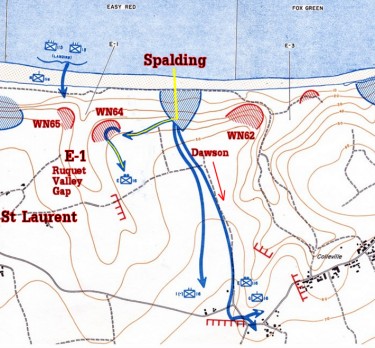 |
Spalding and Dawson still had to
contend with foxholes, pillboxes, snipers, mines, and barbed wire -
no easy task to be sure -
but they outnumbered the Germans and had nearly equal firepower. Plus
they had the natural cover of uneven terrain to help disguise parts
of their climb.
By some fluke
of D-Day, both platoons were fortunate to begin their attack at one of the
few places on Omaha Beach
where an American soldier actually had a fighting chance.
The Germans still had the high ground, but not enough weapons to
defend this vast amount of space adequately. Unlike the
thousands of men still pinned down on the beach, Spalding's men had
room to maneuver. So did Dawson's men.
Furthermore, as we will
soon learn, some of the enemy defenders would turn out to be Polish
conscripts who would far rather shoot at the Germans than shoot at
the Americans.
So what explains the
weak spot? Rommel simply did not
have enough men to cover every inch of Normandy effectively. If
he did have enough men, would he have put Polish prisoners in charge
of firing the machine guns? I think not.
|
|

More about the Weak Spot Between the Colleville and St. Laurent Draws
(from John Hamill's Military History)
This is the approximate area that the group of Company E, 16th
Regiment landed. The 1st Division men under Lt. John Spalding
landed at 0645. They strode across the beach as fast as they could. Taking flanking fire, they got 20 of their 32 men across
the beach. They had landed at a weak point in the German defenses
between strong points, about halfway
between the Colleville
(E-3) and St. Laurent Draws (E-1).
At this point,
WN 62
500 yards to their left dominated the Colleville Draw. To their right,
WN 64
dominated the St. Laurent Draw.
However, in the middle of the strongpoints,
the resistance was much weaker.
To their front in the distance the bluffs had minefields, trenches,
and German soldiers, but nothing like the defenses at the draws.
Immediately to their front were three run down houses with stone
walls. Blowing a hole through the wire with a bangalore torpedo,
Spalding's men immediately went forward through the gap, past the
run down houses to a minefield at the foot of the bluffs. Seeing a
somewhat sheltered route up the bluffs, platoon sergeant Phillip
Streczyk led the men up the hollow, despite the mines that the
Germans had laid to protect the vulnerable area. Amazingly, none of the men set off mines, although later groups would.
At around
0700, another wave landed near Colleville Draw, also with bad
results, including the death of a battalion commander. Near here,
additional troops landed as well. Some tanks were now on the beach,
and Company G, 16th Regiment under Cpt Joseph Dawson landed
in six LCVPs. Weighed down with heavy equipment, the men of Company
G walked across the beach. Now
the group had machine guns of their own to fight
back with.
(Source:
John's Military History)
|

Attack
Up the Bluffs
(from
John Hamill's Military History)
This is the hollow, sowed with mines, that Spalding
and Dawson's men climbed on D-Day.
This picture does an amazing job of conveying the protected nature
of "Breakthrough Alley". There was a depression in the land
that reduced sightlines from a distance. To the Americans, it was
like walking in a very wide ditch where only the nearest people
could see them.
Now you begin to see why the soldiers in the two nearby
WN
strongholds had no way of detecting the Americans as they climbed
this weak point in the German defense. Yes, Spalding and
Dawson's men were shot at by the smaller defensive units in this
area and yes, they had men wounded in action, but neither platoon
sustained a single casualty despite engaging in several gun battles
during their climb up the hill. The land mines proved to be a
bigger deterrent than the Germans themselves.
Once the breach was established, more men from
the beach below came
pouring in through this breach to join the fight on the hill. The men from the 116th Regiment
soon joined the attack.
Company
C, 16th Regiment, landed nearby and advanced up the bluffs too.
This area became the initial penetration of the entire beach on
D-Day.
The breach
made at Breakthrough Alley marked the beginning of the end for the German defense at Omaha
Beach.
(Source:
John's Military History)
|
|
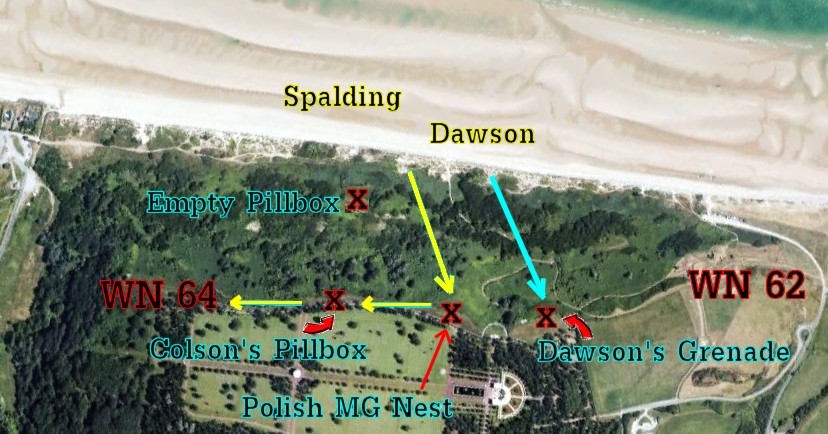 |
Rick Archer's Note:
I created this map
based on what I learned from my May 2010 visit to the area plus the
various reports I read. I cannot guarantee the accuracy
of this map, but I thought the reader would enjoy getting a rough
idea of the probable locations described in the narrative above and
in the individual stories of Spalding and Dawson.
The Empty Pillbox was likely to be placed somewhere between
WN 62
and WN 64.
The Machine Gun nest that Dawson took out with a hand grenade
was probably on the bluff to the right of the viewing platform.
The Machine Gun with the Polish Gunner was likely on the
bluff to the left of the viewing platform. Colson's pillbox
had to be somewhere halfway btw the two bluffs and
WN 64.
|
|
John Spaulding's
Story Continued
(note: Spalding's Company E began
to climb the ravine 10-15 minutes ahead of Dawson's Company G)
|
After reaching the sea wall, Spalding and his E Company
were trapped on the beach
by a deadly combination of gunfire and a thick stretch of barbed
wire. No man could possibly cross barbed
wire that thick. The only way to break out of the trap was for a man to risk
his life by crawling forward with wire cutters or Bangalore
torpedoes – 20 pound tubes packed with explosives – and attempt to
cut the tangle of wire while exposing himself to enemy fire.
Sergeant Curtis Colwell
bravely made a dash for the wire. He used
his bangalore torpedo to blast a hole through the wire despite every German
weapon in range shooting at him.
The
Germans seemed to understand full well what this penetration could
mean, but their efforts proved futile.
Suddenly
Colwell was through. He
began waving for the troops to follow him.
Spalding wasn’t going to let
this
heroic effort go to waste. Spalding
had 20 men left. He gathered
these few men
and burst through the
opening as fast as possible. The men
had to
dodge a furious
barrage of rifle fire, machine gun fire, and mortar shells.
Once the men were through,
this
was the break they needed. Amazingly, after they passed
the barbed wire and
reached the hill, the shooting stopped
completely. Were they invisible or something? Spalding
looked up and saw nothing. If he couldn't see them, maybe they
couldn't see him either. Spalding decided they were
apparently tough to see from above.
This gully in front of him looked deserted. Maybe it was only
the beach that was covered with crossfire.
Spalding's Narration:
"The
first place we stopped was at a demolished building; there was some
brush around. We were halted there by a minefield at the first
slope. My section was spread out—the men in accordance with orders
had deployed the minute they hit the beach. They had been told to
get off the beach as soon as possible. They walked on across because
nobody stopped them. The company was
getting heavy small arms fire. One
burst from a machine gun left a series of
dots along the wall in front of the men.
Sgt. Louis Ramundo was
killed here, the only man killed in my
section on the beach."
Spalding and his men crept
forward. Spalding spotted a narrow path up the hill and began
following it. He stopped cold when he noticed a dead soldier in
front of him. Spalding recalled thinking, 'What the hell is this
guy doing here? How did he get ahead of us?'
The man’s body was torn to bits.
That was all the clue Spalding needed to realize
the man had stumbled on a mine
field. Spalding was immediately on guard.
As he crept closer, Spalding realized the dead soldier was a
German. Of all the luck!
Spalding Interview:
"Streczyk and Pfc. Richard Gallagher (who won the Distinguished
Service Cross that day as did Sgt Colson) went forward to
investigate the minefield. They decided we couldn't cross it.
We had to stop. There was pretty heavy brush around there."
Then someone pointed out
places where there was no grass growing. Spalding smiled
grimly. He figured that was a 'dead giveaway'... if the grass
couldn't grow, there was probably a mine underneath. Spalding
ordered the men to walk on the grass, not on the path.
That little twist on the old axiom worked.
There were no bullets at this point. Where was the enemy?
Spalding guessed they had protection from hostile observation and
fire provided by the hills on either side of the gully. At the
time, the terrain was helping to shield them from enemy fire or
observation. Spalding had a hard time accepting that this hollow
was so poorly defended. Other than mine fields, there seemed
to be no other obstacles. Where was the defense?
Once they passed the minefield, the men
resumed their ascent.
There were grass fires everywhere from the day's
constant shelling. Using smoke from the many grass
fires for concealment, the men systematically climbed
towards the bluffs.
Spalding could not believe their good fortune.
This part of the hill had to be one of the few places
where the enemy defenses were weak. On the
way up, there was not one machine gun
nest to deal with. Spalding recalled thinking that perhaps a bomb
from the morning barrage had found the bunker
guarding this area.
Spalding Interview:
"On
our left we bypassed a pillbox, from which MG
(machine gun) fire was coming and mowing down F Company
people a hundred yards to our left.
There was nothing we could do to help them. We could still see no
GIs to the right and there was no one up to us on the left. We
didn't know what had become of the rest of E Company.
Back in the water, boats were in
flame. I saw a tank ashore about 0730-0745 and
get blown up. Then I saw more men
getting mowed down. After a couple looks back,
I decided I
wouldn't look back any more. I couldn't
bear seeing all those men dying back on the beach.
About
this time Gallagher said to follow him up the gully which was about 400 yards to the right of the pillbox
we just passed.
Finally we spotted resistance. They must have seen us
up top because now we
were getting terrific small arms fire.
Fortunately only a few of the men were hit. About this time we were nearly at
the top of the hill. We returned fire but
couldn't hit them."
Narration by Sgt Walter Bieder: "All
hell broke loose when we hit Omaha Beach. The tide was out, so
we had an extra long beach to cross with a lot of obstacles,
including land mines. Only four guys from one of our landing craft
got out of the landing craft alive.
When they dropped the ramp of the landing craft, the Germans
cross-fired right into
it. Four guys jumped off the rear of the landing craft; that's how
they got out alive.
It was so bad on that beach, I can't find
the words to even describe. All I can remember is that night
my company commander (Wozenski) broke down in tears. He cried
because he said they lied to us. The beach was supposed to be
full of bomb craters. We were counting on them being there,
but there were not any holes around to use for cover. He said,
"There's only 60 men left. Where's my men? Can you
believe that? I just lost 140 of 200 men!"
And he broke
down and bawled like a baby. Hey, it didn't bother me none to
see him cry.
A lot of us cried that day and we weren't ashamed of it. We
earned the right to cry.
I don't know how we made it, but we were determined to made sure our
buddies didn't die for nothing. Our
platoon leader was Spalding. He was young
and this was the first action he had ever seen. What a way to
start! But you know, he did pretty good. When we were
going up that hill there and when we got pinned down way out in
front, I thought he held his head pretty good.
Spalding’s platoon, we made our way up the hill and kept
pushing. We were sort of spread out.
Spalding didn't want us together in case of a hidden machine gun.
Piasecki and a couple
of other guys were around me.
Our first platoon got up there and we began
taking fire from this machine gun nest. It was set not on top of the hill, but
just a ways down and dug in. I had a grenade launcher on my rifle.
It was an armor piercing grenade, but not like a hand grenade.
I slipped
a hand grenade onto the launcher of my M1
rifle and fired. I barely missed. It
went boom right in front of them. So I
quickly put another one on, brought her up a little bit, and boom —
I got them!
Farther up, in a little ravine, was a small anti-tank gun and I
aimed at that and I hit that too. And then
my rifle, I don’t know what the hell happened with it, the mechanism
fell apart, and I had to grab a rifle I found laying
around from one of the
guys that was hit.
I also got a couple snipers to throw up their
hands. I took them back down the ravine and left them there so
I could rejoin the men. It wasn't easy, but our platoon was clearing
small resistance units along the way as we scaled the hill."
Spalding Interview:
"We were getting
pounded by a machine gun nest we couldn't see.
When Gallagher found the way up I sent word back for my men to come
up to the right. Sgt. Hubert Blades, Sgt. Grant Phelps, Sgt. Joseph
Slaydon, and Pfc. Raymond Curley went first. I went next; Sgt. Bisco followed me and the rest of the section came along.
I
couldn't take my eyes off
looking for the machine gun above us, so Sgt. Bisco
kept saying: "Hey Lieutenant, watch out for the damn mines."
He was right. I was so worried about
the MG nest I almost stepped on a mine.
They were a
little box type mine. Now that I paid
attention it seems that the place was infested with
them, but I didn't see them till Bisco warned me.
Bisco
saved my life.
We lost
no men coming through them, although H Co coming along the same
trail a few hours later lost several men. The Lord was with us and
we had an angel on each shoulder on that trip up
the hill.
We knew where the shooting was coming from, but
we couldn't see the gun. Trying to get the machine gun above us,
Sgt. Blades fired his bazooka and missed. He
was shot in the left arm almost immediately.
One down. Pfc. Curley, a
rifleman,
was shot next. Two down. Sgt. Phelps had picked up Tilley's BAR
(Browning Automatic Rifle) on
the beach after he was hit. Phelps tried to move into
position to fire and got shot in both legs.
3
men down. Damn it. This
German unit was putting up a good fight. Pretty soon I was
going to lose a man if we didn't disable this post.
By this time practically all my section had moved up.
We decided to
rush the machine gun from about 15 yards away.
You
may ask why we hadn't been able to
hit it yet. I don't
know. We sure tried hard enough. But
we couldn't see them! Then just as we rushed,
the
German operating the gun threw up his hands and yelled "Kamerad!
Freunde!"
I told the men to hold their fire. I kept looking for the other Germans to join him. No
one. I couldn't believe that just this one guy did all the damage.
'Comrade-Friend' my ass. We
should have killed him
for plugging our three guys, but we needed prisoners for
interrogation. I ordered the men
to stand down. At the time I still couldn't
believe this one single guy had kept us pinned down so easily."
Rising up from a
hidden foxhole on top the hill, the machine gunner had decided to surrender.
The man began sliding down the slope on his backside with his hands up. At
this point, Sgt Streczyk took charge.
Narration by Vinnie
DiGaetano:
"This gunner had been in
a one-man foxhole and
he’s been giving us hell. Finally,
we get around behind him. He could have
surrendered a long time ago. He only threw up his hands when we got
behind him and put a gun to his head. Smart
guy [Laughs] He
started talking
Polish. That’s when we finally found out he
was Polish. We don't know Polish, but
Sgt Streczyk does.
Streczyk asks this
Polack why
they shouldn't shoot him on the spot. The guy
says, “I got captured, I don’t want to shoot!”
This guy was a one-man foxhole and
shooting at us like crazy!
Now he tells Streczyk he was trying to miss the whole time!
Hell, the SOB hit three of our guys. I hate to think how many
guys he woulda hit if he was aiming! I guess he decided to
give up before he killed someone.
So Streczyk
keeps talking to him in Polish and
says he doesn't believe
the guy. Streczyk whacked the prisoner on the
back of the head and
yelled, “So why the hell are you shooting
at us?”
The gunner was scared
out of his wits. He
kept insisting he had not shot any Americans.
Streczyk looks at him wild-eyed and screams
something in Polish, probably "Whaddya mean you ain't shooting
at us? You just shot three of my guys!"
Streczyk looked like he was ready to kill the guy so I yelled, “What the hell are you doing,
Streczyk? Ease up!" Pow!
Streczyk whacked him again for good measure!
Streczyk was boiling mad. Didn't believe a word the guy said.”
Narration by Joe
Buck: "[laughs] Later on Streczyk was coming back down the hill
with a bunch of prisoners of war. There were
all these Polish prisoners and
Streczyk was
kicking them in the ass the whole way down and talking to them in Polack wanting to know why
they fought so damn hard.
Streczyk was really raising hell with them!"
But let me tell you, Streczyk's tough
interview paid dividends. The Polish gunner explained
he was
captured by the Germans and forced to fight against his will.
He said that there were 16 Germans in a trench to the rear
of his machine gun. These Germans
had told their Polish prisoners that
morning that they had to hold the beach
no matter what. The Germans said
they would shoot them in the back if the Polish didn't seem to be
trying to fight.
After the interview, we decided to go find those 16 Germans in the
trench."
Spalding's Narration:
"The Polish men
had taken a vote on
whether to fight and preferred not to, but the German noncoms made
them. He also said that he had not
shot at Americans, although I had seen him hit three. I turned the
PW over to Sgt. Blades, who was wounded. Blades gave his bazooka to
Sgt. Peterson and guarded the prisoner with a trench knife.
We moved Curley, Blades, and the other wounded
men into a
protected area and the medic—Pvt. George Bowen—gave them
first aid. He covered his whole section of the beach that day; no
man waited more than five minutes for first aid.
Bowen's action did a
lot to help morale. He got the DSC for his work."
Now that the Polish MG nest was knocked out, the men were finally
able to reach the top of the hill. There were no immediate
threats. While Streczyk was occupied with
gaining intelligence from the prisoner, Sgt. Clarence
Colson decided to proceed further on his own.
Colson and his
buddy Sims noticed a pillbox nearby. They were behind it.
The pillbox could not possibly know there were Americans on top of
the hill. Sensing that he had the
drop on them, Colson decided to make this pillbox his personal
project. Earlier Colson had picked up a Browning Automatic Rifle (BAR, a
light machine gun) on the beach. As
he came up
along the crest of the hill,
Colson began to give assault fire as he
walked along. Colson rushed the pillbox, firing the weapon from his hip
as he ran. Colson
opened up on the machine gun nest firing so rapidly that
his ammunition carrier had difficulty getting ammo to him fast
enough."
Sgt. Clarence
Colson's Narration:
"When
we were at that demolished house, I looked at the terrain in the
gully in front of us. So when I seen that path and all these
wires I knew there’s minefields there. I told Sims to watch
out. We got a BAR on the beach from a
guy that was wounded. And we got a few magazines. I brought the
extra magazines and we got some bandoliers (a belt of ammunition) that we
carried. And I said to Sims, "C'mon, let's head for the hill."
So I went up the path. Quite a steep hill.
There was no wires across the path, that’s what I was looking for,
and running as fast as I could run. 'Course I was young then, I
could move pretty good. And when I got over there, then I motioned
Sims to come. And Sims came up. And he had the
bandoliers. So we got top of the hill and that’s where all the
trenches were. Damn. Trenches everywhere!
Those Krauts must dig in their sleep.
And here is this one guy running back and forth
in that trench, so I hollered at him "aufgeben", give up. SOB
threw a potato masher at me, a German hand grenade. I ducked down, put my
hands up, my head down. It didn’t go off right quick and I kind of
glanced and I see he hadn’t unscrewed the back and pulled the
string. Big mistake. So I nailed him.
This pillbox was the one that was holding the Company up. The
pillbox was down at the end of the trench. Now I could
use the trench to come right down the back end. Maybe they
heard me shoot the guy in the trench, but they couldn't
see me. The pillbox had a door that
goes downstairs, then you have your gunner slots, see. So I
got the BAR. It had a tripod on it and I got it set up right, opened
the door and started
spraying.
I told Sims, I says, “Just as soon as I kick that
magazine out, put another one in.” There was 20 rounds, I think, in
those magazines. So we shot about three or four of them. Maybe more,
maybe less. I know it was more than three. We shot quite a few
rounds.
All of sudden a white flag came out and I quit firing. A
bunch of Germans came
out. I motioned for them to come on up and they came up. I
don’t know how more many was dead in there or anything. But it
was a good thing to stop these guys. Without that pillbox, the
beach just got a whole lot safer.
That’s why we got all the troops up, pretty soon, on that part of
the beach."
Spalding's Narration:
"Shortly
after
Colson took out the pillbox, Lt. Bleau of G Company came up and contacted me. He
said he had come up our
same trail. His company had landed in the second wave
behind us. Just a few minutes later Capt Dawson of G Company came
along too. Now that the
pillbox was gone, we saw no one on the
right. Captain Dawson asked if I knew
where the rest of E
Company was and I told him that I didn't know.
Dawson
said that E Co was 500 yards to my right, but he was thinking in
terms of where they were supposed to land; they were actually
500-800 yards to our left. I later found out that they had lost 121
men. Dawson said that he was going into Colleville and told us to go
in to the right. He had about two
sections. Said he had just seen the battalion commander. This was
about 0800. We had been fighting for an
hour.
I
went over and talked to Lt. Bleau about the information we had gotten from the
Polish prisoner. I asked him
to give us some support while we looked where the 16 Germans were supposed to be.
We
drifted to the right, or west if you prefer. As we went
up in this direction we hit a wooded area. We found a beautifully
camouflaged trench which ran along in zigzag fashion, but we were
afraid to go in. This was the trench the
Pole had warned us about.
We went along the top of the trench spraying it with lead.
We used bullets instead of grenades
since we had very few grenades. We
thought that the bullets would be more effective. No
one shot back, so Streczyk looked around a corner. No
one in the trenches. Deserted. Afraid of an ambush, we turned to the right and
shot at a wooded area; got no fire from there either.
No one. False alarm. I began to wonder if the Polish
gunner had fed me disinformation.
Well, no need for G Company to hang around. So I yelled to
Lt. Bleau to shove off and he started for
Colleville to catch up with Dawson. G
Company went on to Colleville-sur-Mer. My
company headed west in the general direction of
St. Laurent.
As I watched them go, there I stood like a damn fool waving
Lt. Bleau a fond farewell.
I caught myself waving and stopped.
How ridiculous."
Sgt. Clarence
Colson's Narration: "Now we
had all these prisoners. That's when
Ramundo
got killed. In fact, he was the first guy. Ramundo
came up the same way Sims and I climbed
the hill. He came up right after we
got the prisoners.
Ramundo told me,
“I’ll go back down to get the company.”
And I said, “Don’t go down there, there’s snipers and
mines around
there, too. Ramundo, stay here. They’ll
come up soon enough.”
But he said, “No, I’m going down after
them.” He went down, I heard one
shot, I said, “Yeah, he’s had it.” Sniper got him.
Just like I said, the Company got up.
But
out of the whole Company we only had, oh, 20 men or so left.
I remember back in the morning, the
boat next to me on the right, none of them got out of it.
We was on the further left.
10 feet made all the difference.
And it
was a good thing for us because that
pillbox near the shore wasn’t manned.
They didn’t have nobody in it.
That pillbox would have been a real problem
for all of us.
Instead it was empty. Now we were at the
top of the hill. Looks like we had all the luck today.
From here on we just scattered out and
moved forward looking for German resistance.
That was all we could do."
|
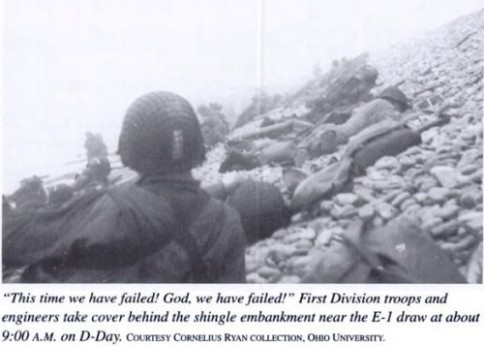
The utter hopelessness
of the situation was increasingly apparent. Across the beach,
the perspective was the Americans had lost this battle. This
explains why Dawson and Spalding's breakout was so crucial.
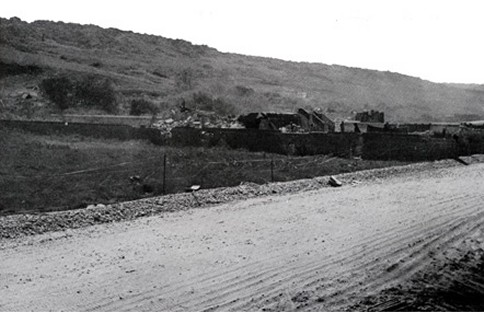
This picture was taken
after D-Day which explains why the road is in such good condition -
it was just built. According to Spalding, this was the demolished
building they used to hide from German bullets.
Why the Germans allowed this
building
to stand to be used as cover on the beach can't be explained. It remains
a mystery. They said that the nearby strongpoint WN64
wasn't finished either.
One can imagine if Eisenhower had waited
till the next full moon, perhaps all the gaps in the defense around
here would have been gone.
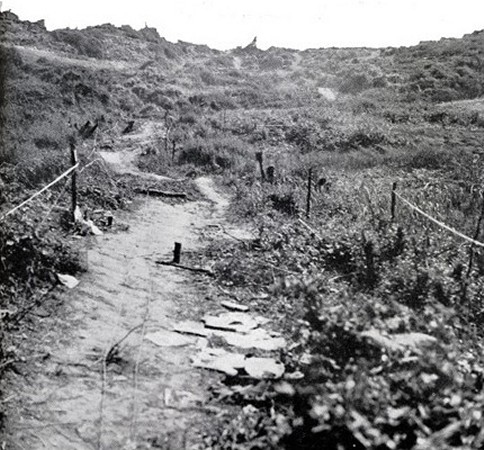
This
is the area Spalding's company crossed on their ascent. The ropes
suggest a minefield
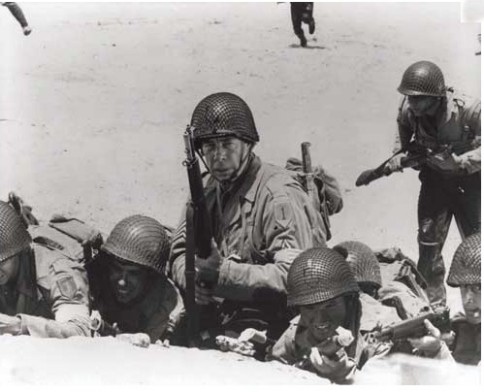
The sea wall saved
countless lives
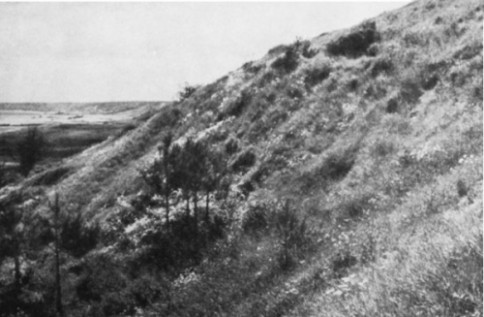
This
is one of the two
hills on the side of Spalding's ravine.
As you can see, it was very steep.
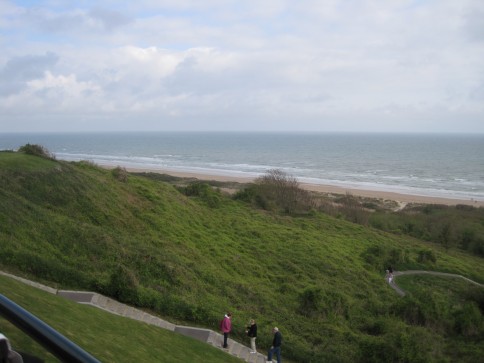
I can't be certain, but I
believe this the spot Spalding's men were climbing when the Polish
machine gunner began shooting.

Wherever Spalding went, there were defensive trenches
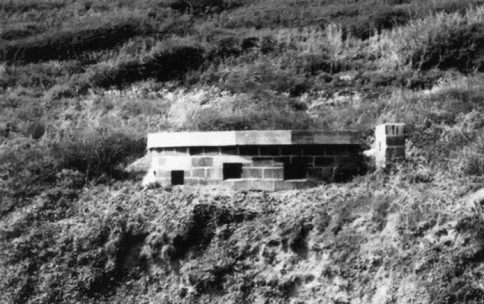
During the climb to the
top, a pillbox began firing on Spalding's men.
Sgt Colson took it out single-handed
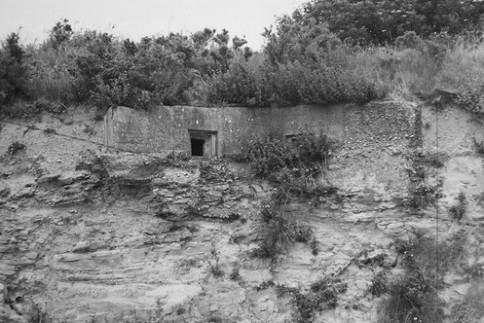
The Germans were masters at
disguising their fortifications.
You would have to look twice to spot this pillbox.
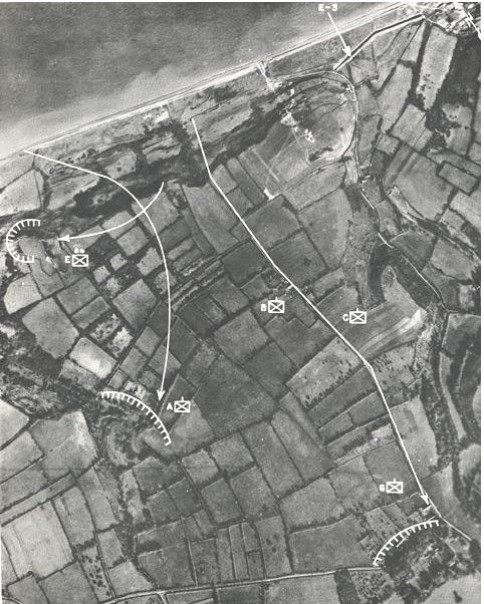
I found this map titled
"Spalding's Movements" with no accompanying explanation. There is ambiguity
in this map that I am uncomfortable with, but my best guess is that Dawson and
Spalding both came up the same hollow together about 100-200 yards
apart separated by about
15 minutes.
After taking turns
clearing out the bluff at the top of the hollow, at that point the
two company leaders talked over their next step. Dawson
went on straight to Colleville while Spalding turned perpendicular to
move west toward WN64. The sideways route is probably Spalding
moving on WN64.
Sorry to say, but I
don't have a clue what that long curved white line represents.
It might be Spalding, but I think it is the movement of another
company. Spalding ended the day with Dawson in Colleville.
I don't think that curve is him.
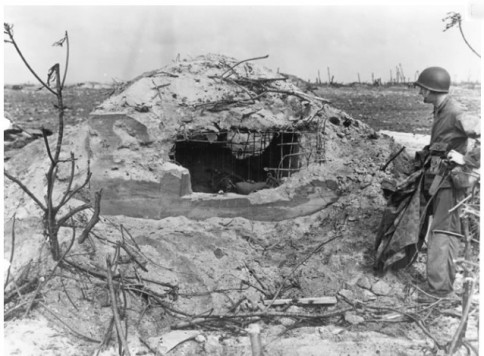
This is about what
Colson's pillbox looked like after he was through with it.
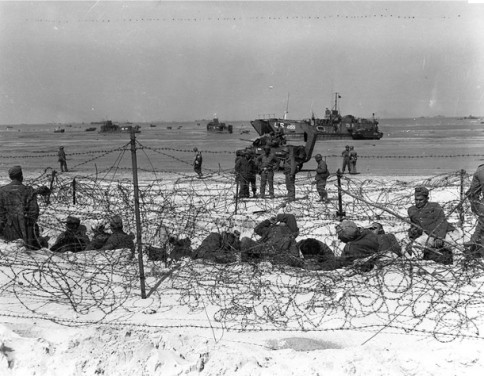
German prisoners of war on
Utah Beach... and a good example of the barbed wire the Americans had to
penetrate to move upward
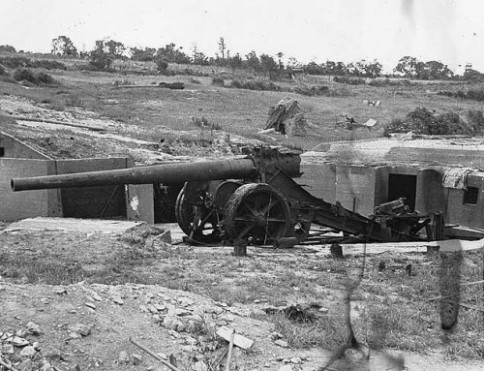
For reasons no one can
explain, there was no artillery on the ridge for Spalding's men to
worry about. And why was the shoreline pillbox that Colson
noticed early in the morning unmanned? As bad as it was
at Omaha, if it had been better staffed, things would have been far
worse.
The history of the day
shows that the Germans were vastly outnumbered. However very
small German detachments were able to keep the much larger invading
force completely bottled up. For example, 31 men at WN62
held out for nine hours that day killing over 1,000 Americans in the
process.
WN62 was too strong to
be taken by frontal attack. It was only when GIs
filling the breach created by Dawson and Spalding came in on WN62
from the rear that the mighty stronghold started to weaken.
At 3 pm, WN 62 finally fell. By comparison, WN 64 went down at
10 am.
Without the
breach created by Spalding and Dawson, many more men would have
died. This underscores the magnitude of what Company E and
Company G accomplished that day.
|
|
|
|
|
|
Joe Dawson's Story Continued
(Dawson was pinned
down behind a log by gunfire from the top)
|
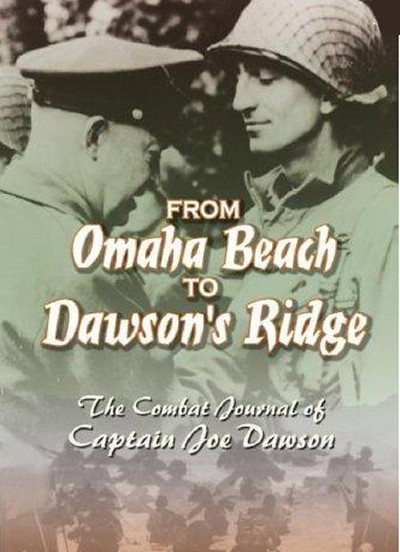 |
Dawson's Narration: "I was up
there pretty much alone. Me and three other guys had
reconnoitered. I decided it was safe enough to
bring the whole company up, so I told Baldridge to
go back and bring the men up. I said, “They’ve got
to get off the beach. Tell them to come up here with
me.” Baldridge took the two guys with him and
went back down to deliver the message.
So I
climbed a little more, then waited on the ground behind a log.
No one was shooting at me, but I didn't
see any point in staying exposed. I watched to see if my men
were
coming. Pretty soon they began to
filter in. I could see a single file beginning to
develop off the beach and coming on up.
That's when I heard a great deal of noise just above
me. Sure enough, there was a machine gun nest
up there that had just sprung into action. I had no
idea they were even there! I couldn't even see
them from where I was, but I could see they were giving the men a lot of
trouble. Down below, my men scattered for
cover.
I decided to get closer.
I couldn't see the gunners because the hill was so
steep at this point and I was below them.
However I
could use the sound of the gunfire to guide me closer till I was in
view. Then suddenly I had a new angle and
spotted them above me. From this point, I
crawled along in the brush till I was
able to get within a few yards of them. I
was no longer under them, but rather beside them. The Germans were right
on the crest hiding in a trench with only their gun
exposed. They were well disguised. No wonder I hadn't seen them
before. They were practically invisible if you
looked at them from any spot down below.
Suddenly the Germans spotted me and they were scared out of their wits.
They hastily swung
their machine gun around, firing wildly. I
ducked for safety, but
wasted no time retaliating. I had a couple of
grenades ready and I lobbed them both in there.
It was point-blank range. One of them fell right between both men and silenced them instantly.
|
Sure enough, that opened the beach up. It was a
miracle. It doesn’t mean anything on my part. I
certainly didn't plan to take on an entire machine gun nest myself.
It was just one of those wacky things that happen, that I was in the
right spot to take them out. They never had any idea I was
nearby.
The top was clear now.
E1 and
E3 were the two exits that we had anticipated would
be the exits off the beach. We didn’t get them open
until the next day. And the only place on which that
whole beach was able to get off was through that
point that we established on the bluffs.
At that point
we began to move towards Colleville. It wasn't easy.
We had several firefights from the bluffs on into the village of Colleville. But we were successful in being able to do
it as a unit. My men did a superb job on getting
there.
There was a
calm over us. There was a mutual respect that began to
develop, and it was almost incredible. I felt it in every
one of my men. We had casualties. We had lost men there on
the beach. We had two or three men who suffered in
this battle. But we hung together strong.
Soon we took
our positions in the town. I led my men in there and
we had quite a fight. The little village was dominated
by a church with a steeple in it. One of the forward
observers of the Germans was using that steeple to direct
artillery fire down on the beach.
So I went into the
church with two of my men, a sergeant and a private. We
had a little encounter in there with the Germans. And
I lost the private. The sergeant and I both were able
to survive and we were able to neutralize the situation.
I left the
building and started across the street from the church.
There was a typical French farmhouse. The farmhouse
was enclosed with an open courtyard but with the farm
buildings making somewhat of a square. And it was
there that the bulk of my men congregated after we had taken
the village.
And as I was
going across the road, a sniper caught me with a bullet
through my left knee. It frightened me. I was
carrying a carbine. That was the only time that I had
a weapon other than my 45, but I had that carbine. The
bullet had gone through the stock and one of the fragments
had lodged in my knee. Another fragment came through
the fleshy part of my right leg, which somewhat
incapacitated me. But I didn’t think anything about it
at the time. I just got out of there.
|
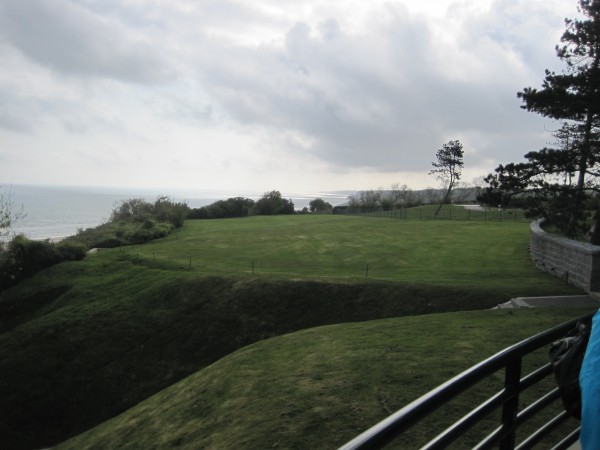
Based on Dawson's
story, I think there is a good chance the hidden machine gun nest
was on this bluff to the right. I say this because it gets
very steep here. I could imagine how Dawson could be right
underneath this area and not be seen by the machine gun nest hidden
in the bushes.
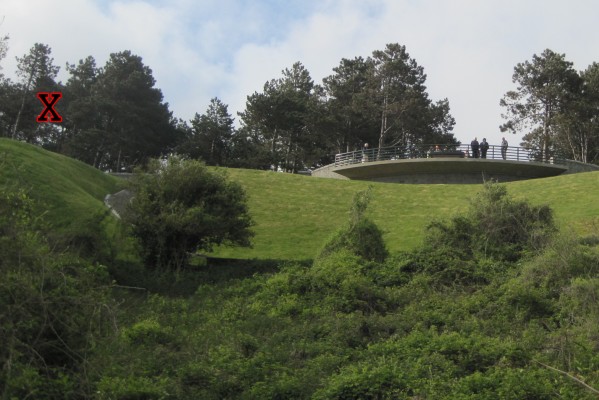 |
I moved my men
into a defensive position around the town. Soon after
that there was a little firefight that developed from the
Germans that had shot at me down at the end of the street.
Other than our farmhouse, they had the town completely in
control. This was about 0330 in the afternoon.
At 0400 out of
nowhere bombs started flying overhead. I couldn't
believe it. We
were being devastated with artillery barrage from our own navy.
The barrage leveled the town, absolutely leveled it, and in
doing so we got hit too. We suffered the worst casualties we had the whole
day. I was angered by it. We were hit harder from our own navy
than the enemy! It angered me
beyond all measure because I thought it was disgraceful.
My own navy had bloodied us from one end of the town to the
other. I lost more men to my own navy than to the
Germans all day!
And I was
quite bitter about it. Captain Wozenski was very bitter
about it too. We brought the matter to the attention
of the authorities. The navy’s response was that the
order called for the leveling of Colleville at H+60 minutes
or as soon thereafter as visibility would permit.
Well, the pall
of battle was over us. And there was no vision and we had no
communication because my control officer, the navy-army fire officer, had
been destroyed on the beach eight hours ago. Thanks to
his unfortunate death, I had not been able to identify
my company's whereabouts until after the barrage leveled us. And by that time
I was frantically throwing up smoke bombs to alert them to
the fact that we were in the town, but it was too late to
prevent the barrage from occurring.
But their
contention was that the pall of battle had obscured their
vision until 4:00 that afternoon, which was H+8 hours or
H+10 hours. This snafu cost me 64 fine men killed or
wounded. With the exception of the tragic loss that
morning when the bomb hit the boat behind me, this was the
worst loss we suffered all day. I thought it was
disgraceful the Navy would be so careless to bomb Colleville
without checking to see if there were any Americans there."
Although
Dawson had trouble containing his contempt for the Navy's
recklessness, he was undeniably proud of his own men. Dawson pointed
out that while other companies had fallen to pieces at the
hands of the brutal German defense, his men had bravely gone
about their business. Between his men and the men from
Spalding's company, all resistance on the bluff between the
E-1 and E-3 draws was eliminated. The gap opened by G
Company was quickly exploited by hundreds of fighting men
who came in right behind them. This initial
penetration allowed the men on the beach to safely follow
their path and join the fight. Indeed,
the men who followed were able to take out the notorious
WN 62.
Dawson's
Narration: "I took great pride in what my men
accomplished. We landed 34,000 men at Omaha, but it
took 250 men to open the way."
|
|
|
|
The Conclusion of John Spalding's
Story:
The
Fall of WN 64
|
Rick Archer's Note:
Today there is
German concrete all along the French coast. Wherever
there is a beach, there is some grim concrete reminder of the past.
WN64 and WN65 guarded the two sides of Ruquet
Valley. WN65 (pictured) still exists today.
WN65 was located 200 yards across the Ruquet
Valley from the heavily forested hillside of WN64.
WN65 has all sorts of bunkers to see such as the one
pictured. This bunker can also be seen in the
picture below directly under the "1" in "E-1".
Unfortunately
I was unable to find even a single picture of WN64
on the Internet. Not one. No D-Day
picture, no modern day picture. That is
probably because WN64 was meant to be concealed in
the heavy forest.
|
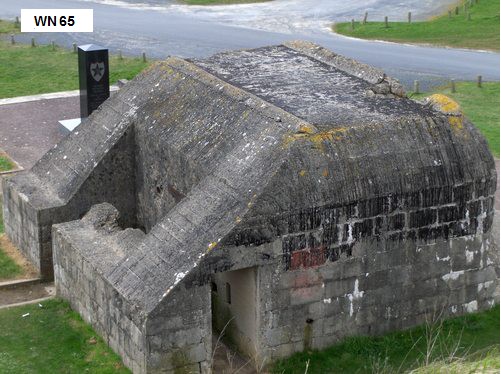 |
|
A cursory glance at the
hillside using
Google Earth
close-ups around the 'Question Mark' revealed not even a
single bunker left standing in the area.
It is
like the place never existed.
The
Germans were masters at disguising their fortifications.
This is the most likely explanation for the disappearance.
Whatever remains today of WN 64, it must be well
hidden somewhere within that hillside forest.
|
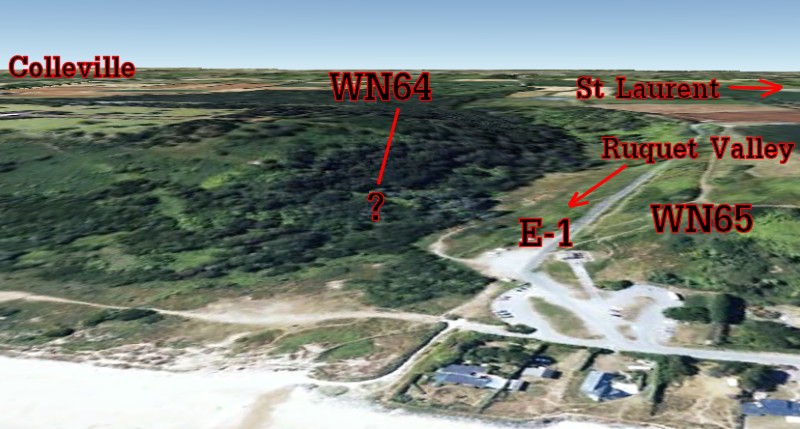 |
|
Spalding's
Narration:
"After Colson
took out the pillbox,
we were
on top of the hill by 0900. We were the first platoon of the 16th to hit the top.
From there we advanced
cautiously. I had 22
men in my section. Seems like I had
spent more time at the rubble than anywhere else.
Plus I had taken up some
time with that Polish prisoner.
|
We never did
find those 16 Germans the Polish gunner had told us about.
It spooked me because I assumed they were still hiding
behind some tree ready to pounce.
Our men were
spread out wide over an area
200-300 yards. As we went
inland we heard rifle and machine gun fire to our
right.
Streczyk and Gallagher volunteered to check
on the situation. They located a machine gunner with
a rifleman on either side of him. Streczyk shot the
gunner in the back and the riflemen surrendered.
The two prisoners were German.
They refused to give us any information. With them in
tow we continued to the west.
We still saw
no one to the west, but we could hear
artillery firing somewhere out ahead of us.
Visibility was poor. When we
climbed the ravine earlier, the Germans had cleared much of
the vegetation.
However, now that we had breached
their defenses, we
were now in hedgerow and orchard country.
The woods were quite thick at the top of the hill. We
were watching our flanks and to the front and scouring the
wooded area.
|
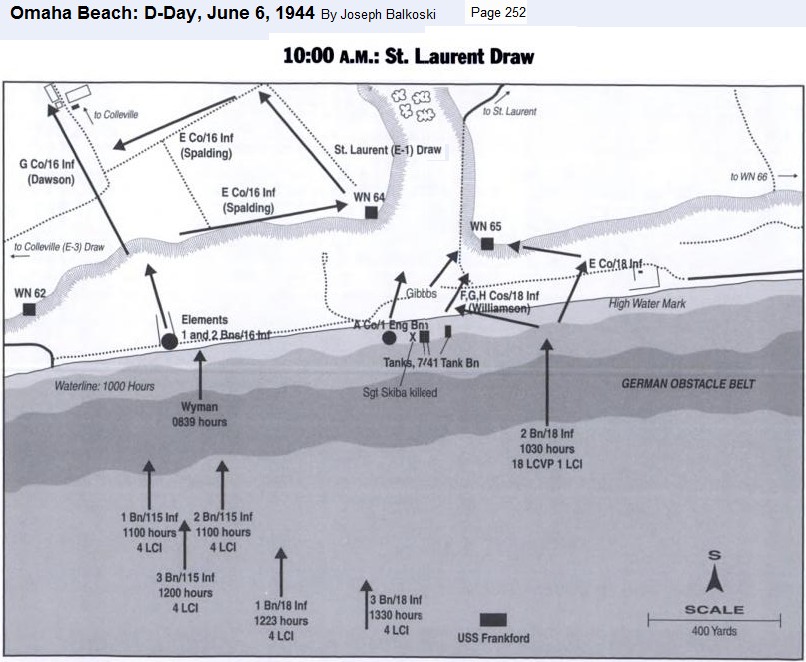
As
Balkoski's map indicates, after meeting at the top of the hill, Dawson's company moved south towards Colleville
while Spalding's company headed west towards the well-disguised WN64
stronghold.
|
|
We couldn't see them
and they couldn't see us.
I would send
Sergeant
Streczyk with 3-4 men
to check on suspicious areas.
We
usually sent someone with an automatic weapon to cover
them. Too bad we did not have any heavy
machine guns at this time.
They were currently sitting at the bottom of the English Channel.
We crossed
through two minefields—one had a path through it, which
looked like it had been made a long time
ago. When we got
through it, we saw the
"Achtung
Minen" sign ('watch out for mines').
No one was lost; we still had an angel on each shoulder.
About half a
mile west from the spot where we first reached the top, we found a
construction shack overlooking the E-1 draw to St. Laurent. Sgt.
Kenneth Peterson fired his bazooka into the tool shed, but
no one came out. The area was heavily wooded.
We were about to go on when I spied a piece of stove pipe
about 70 yards away sticking out of the ground. Was
that a mortar tube? I formed my section into a semi-circular
defensive position. Something was going on here. Sgt. Streczyk and I went forward to
investigate.
I froze.
It was indeed a mortar tube and we
had just discovered an underground dugout. I signaled
for the men to get down. There, dead ahead, we spotted
the German strongpoint. There was well-concealed
concrete.
This had to be
WN 64. What else could it be?
We had been looking for this place all morning only to
completely stumble on it. I could not believe how well
something this big could be hidden from view. Most of
it was submerged into the side of the hill.
The
Germans must have gone out of their way to disguise the rear
approach of this stronghold as well as the front. They did a good job.
With the heavy forest providing excellent camouflage, we
nearly walked right past it.
As I surveyed
the complex, I swallowed hard. This place wasn't going to be
easy.
WN64 was 50
square yards of concrete, steel, and guns. There was an
81 MM mortar, a position for a 75 cannon and incomplete construction for a
pillbox. Two big pillboxes and four
concrete-and-steel shelters overlooked the beach with
artillery, mortar, machine guns, and riflemen.
A maze
of trenches ran from one end of the strongpoint to the other.
The whole thing might have held 40 German soldiers. Maybe
more. The dugout
was made of cement. It had radios, excellent sleeping facilities,
and
dogs too.
This
concealed strong point with its underground trenches
and concrete-covered dugouts was virtually
invulnerable to
attack from naval or aerial bombing. Besides, no
one could even see it was there.
All this
overlooked the E-1 draw. I remembered from the maps
that this strongpoint had a powerful position high above
Omaha Beach and the road to St. Laurent as well. As I
watched, I could see they were busy firing on the
beach. I set my jaw. They were killing our guys
at this very moment. We needed to take these guys out
ASAP!
Unfortunately,
I only had 22 men. Surely we were out-numbered.
A direct assault was impossible. The attack would have to be
cat-and-mouse, one spot at a time. Sgt. Streczyk
volunteered to lead the attack."
Streczyk's
Narration:
"The need
for stealth was paramount. Our company was badly
out-numbered. Our only hope was to retain the element
of surprise. There were four of us who crept on
our hands and knees to get closer to the outlying bunker.
There was a
German smoking a cigarette on the edge of the bunker.
In addition we could hear voices inside. I
motioned for the men to stay back while I went ahead with
knife in hand. After I sliced the first German's
throat, I picked up his gun and waved to the others to move
forward. When they saw me, I was covered head to
toe in blood. The men thought I was hurt and almost
said something, but I put my finger to my lips to
indicate silence.
Now we were
able to see down into the underground bunker. There
were German soldiers playing
cards. Jesus, there were bombs exploding and men
screaming and these Krauts just sat calmly playing cards.
We determined they were probably reserves for the gun crews. They
were waiting their turn to take over and shoot the big guns.
That's when one of the dogs started barking.
Damn it, we didn't know there were dogs!
Right in the
middle of the deal, the Germans froze and everyone looked
up. I guess the dog had them spooked.
Suddenly, without warning, I used the dead German's
automatic to spray the bunker. I didn't shoot at
anyone so my bullets sparked off concrete and ricocheted
wildly all over the place. Then I stopped firing.
I yelled at them, first in German and then in Polish, for
everyone to give themselves up. I promised them
instant death for anyone who didn't comply. When they
saw me covered in blood, they were terrified. They
threw up their hands. After that it was easy."
Spalding's
Narration:
"After
Streczyk took out the first bunker, one of the men pointed
out a ventilation shaft nearby. I started to drop a grenade into the
ventilator, but Streczyk said 'Hold on a minute'.
Streczyk found the door and
fired three shots down the steps into the dugout. Then he
yelled in Polish and German for them to come out or die. Sure
enough, four men, disarmed, came up. They brought 2-3
wounded with them.
That's Streczyk for you, talking
that Polish gibberish. The guy was magic. I yelled for Colson to bring 5-6 men to
help me watch them. Streczyk went on ahead. Streczyk had just captured this bunker singlehandedly and
spared our lives and German lives in the process."
Side
Note: A post-war article on Streczyk that
appeared in the East Brunswick, N.J. Examiner
referred to Streczyk as "the one-man invasion".
That label surely referenced his actions that
cleared out
WN64.
"We had taken
our
first step in clearing out an intricate maze of trenches and
dugouts. At this point, Streczyk
reloaded and ran to the next trench nearby. Gallagher,
Peterson, and others were right behind him. DiGaetano
got his flamethrower roaring and sent a 15-foot flame into
the gun slot of a pillbox. Smoldering Germans ran out the
back and surrendered. Streczyk swatted his back and
yelled, “Good going, Dig!” After that, DiGaetano
tossed the flamethrower aside because its fuel tanks were empty."
DiGaetano's
narration:
"We got the
flamethrower out and went to a pillbox. The Germans come
out, Aaaaah! They didn’t even know we had a frigging
flamethrower. They were hiding in the back or something. If
you get them, they know about it. Had to be like napalm. In
30 seconds, or a minute, all gone. The tank was empty.
Goodbye."
Spalding's
Narration:
"We began to
get small arms fire from the road to the west of us. I yelled for Piasecki and
Bieder to move forward to the edge of the
draw. A firefight took place. In a trench in
front of me, 14 Germans were cornered.
At first I
thought one of
them had started tossing grenades because suddenly the entire
ground began to shake. But there wasn't any explosion.
I was stunned. It felt like an earthquake. I
asked myself what kind of
grenade can make the earth move like that?
It took us all a few moments to understand what had just hit.
The concussion was not being caused by German grenades, but
rather the US Navy guns.
Once we
figured out what was going on, we all began to smile.
The battle wasn't over, but we were sure we would win this
fight. It made us even more determined to do our job,
assuming of course our own Navy didn't take us out first."
|

Much of the fight
for WN64 took place in deep trenches like this
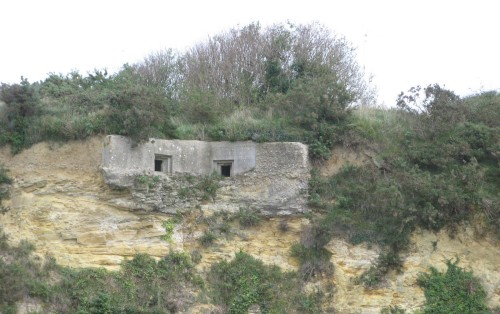
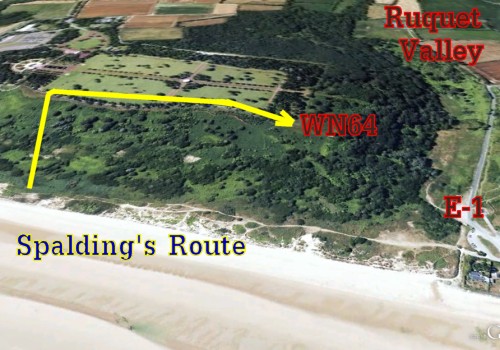
Visualize that
the cemetery area was thick with woods on D-Day.
Spalding's company was walking through a dense forest.
Thanks to
Spalding's discovery, WN64 became the
German's weak link at Omaha on D-Day after Spalding cleared out
the strongpoint at 1000 hours. Only a lone pillbox
at the head of the draw remained in German control until the
evening.
Although WN64 dominated the entrance to Ruquet Valley, it was said to be largely uncompleted by D-day. The
stronghold was undefended from the rear, relying instead on
camouflage to protect it.
The early loss
of WN64 (10 am) was devastating to any German hopes of
counter-attack. The beach area beneath WN64
became the point where the Allies began to bring in supplies
and reinforcements. Any Panzer counter-attack would
have had major trouble dislodging the Americans now.
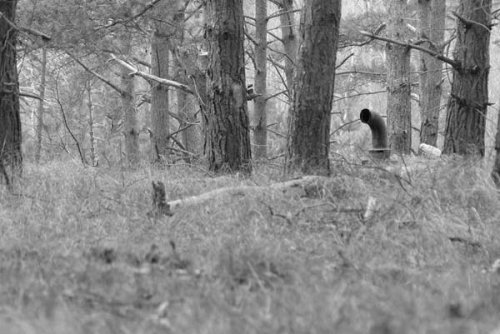
Ventilation shaft for German bunker

|
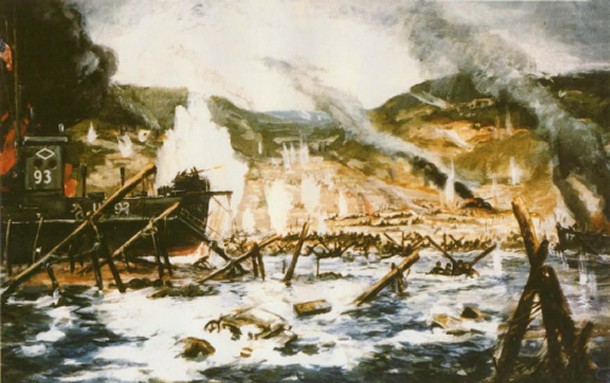
The shelling
incident is depicted in this picture. That is the E-1
Draw. The destroyer is firing at WN65 on the hill on
the right. WN64 was on the hill to the left, but it
was so well hidden the destroyer didn't even realize it was
there. That probably saved the lives of Spalding's
men.
|
By coincidence the Navy
had just begun to place fire into the E-1 draw at 1000. The guns of battleships and destroyers went into action.
Huge shells landed nearby just as Spalding, Piasecki, Bieder, and their squad was
locked in a dangerous firefight with the men in the trench.
Bieder remembered wondering what was going to get him first,
the Germans or his own Navy.
Bombs or no
bombs, the fighting continued. Piasecki
deployed 6-7 men; shot several Germans and chased a number
of men out of the strong point and down the hill straight into the E-1 draw.
There
was a destroyer so close by it was practically sitting on the
beach. The men on the ship spotted their escape.
Now the Germans were sitting ducks. They were
quickly dispatched by
fire from the ship.
Few Germans survived.
|
Meanwhile down
in a trench, Spalding made a mistake that nearly cost him
his life. Earlier in the fight, the lieutenant had
dropped his weapon in a water-filled ditch. He grabbed
a German rifle to replace it, but after fooling with it,
Spalding realized he didn't have
a clue how to use this foreign weapon.
When Spalding began to supervise the first set of prisoners,
he asked one of his men to swap this German rifle for an American rifle. The
soldier flipped on his carbine’s safety lock and handed it
to Spalding. However, Spalding was so preoccupied with
the events, he forget to check out the other man's weapon.
|
|
|
|
Spalding put
another man in charge of the prisoners and went to explore
the dugout. To his surprise, he stumbled on the body
of a dead German. Spalding was somehow shocked to
discover that
his company had killed a German. For some reason, it
caught him off guard. In a daze, Spalding went around
a corner and was suddenly face to face with a German
rifleman.
Reacting
quickly, Spalding pulled the trigger of the carbine, but
nothing happened. The safety was still on!
Before the
surprised German could react, Spalding reached for the catch
but hit the ammunition clip release instead. The ammo
clip clattered to the ground. Now the German raised his
pistol, so Spalding turned to run. At that exact
moment, Sgt. Peterson appeared with his bazooka. The
German saw that if he shot Spalding, Peterson would return
the favor. So he quickly dropped his pistol and put up his hands
instead. Peterson's lucky appearance had just saved Spalding's life.
Spalding's
Narration:
"When Colson came over, I
put him in charge of the prisoners. Then I started down the line of
communications trenches. The trenches led to the cliff overlooking
the beach. We were now behind the Germans so we routed 4 out
of a hole and got 13 more in the trenches. The trenches had teller mines, hundreds of grenades, numerous machine guns.
They had enough ammunition to take our company out easily.
Too bad for them they didn't see us coming. They were firing down at targets in the E-1 draw when we
came up. Then they saw us and turned their firearms at
us.
But it was too late. We had a short
fight with the 13 men. They threw three grenades at
us, but they didn't hit anyone. Once they saw it was
hopeless, they quit.
After the
fight I wandered around and found one dead man in the trenches.
I don't know if we
killed him, but if we did, he was the only German we killed at
this location.
As I
went to check the trenches, I did a fool thing. After losing
my carbine in the water I had picked up a German rifle, but
found I didn't know how to use it. When I started
to inspect the trenches, I traded the German rifle to a
soldier for a carbine, but I failed to check out his weapon.
Seconds after
I found that dead German, I
ran into a Kraut and pulled the trigger, but the safety was
on. I reached for the safety catch and hit the clip release
instead,
so my clip hit the ground. I ran about 50 yards in nothing
flat. Fortunately Sgt. Peterson had me covered and the
German quickly changed his mind about firing his weapon.
So he put up his hands up instead. That business of not checking
guns is certainly not habit forming.
We next took out an Anti-Tank gun near the edge of the draw.
There was little resistance left. We now had the prisoners back
near the dugout. We had split the section into three units.
We got a little ineffective machine gun fire from across the draw
to the right at this time. I figured it was some
Germans in
WN65 trying to come to the aid of their Kamerads. We tried to use the 81 MM mortar
to shoot back,
but no one could figure out how to operate the German weapon.
Now that the
fight was over, for the first time I was in a position to
look out onto the beach below. I saw soldiers across
the draw to the right (west). I supposed that they were from
the 116th. They seemed to be completely pinned down on the
beach by fire from
WN65.
I smiled grimly to myself. Well, at least they didn't
have to worry about
WN64
anymore."
The battle to
take
WN64 lasted nearly two hours. Using the element
of surprise, Spalding's men had started at the rear of this
strongpoint and slowly worked their way forward by attacking
one area at a time. They were aided by the fact that
the majority of the enemy were preoccupied at the front
firing down on the beach below.
The noise of the day
was so intense the Germans firing down on Omaha Beach had no idea some
of the gunfire they were hearing was taking place nearby.
They were unaware of the fight at the back until it was too
late.
Meanwhile, down
below on the Easy Red beach sector, no one knew about the
fight up above. Soldiers, engineers, and medical personnel
only knew that for some unknown reason they could suddenly move without being shot at.
They quickly relayed the message that this area was
mysteriously safe. This became the first safe landing point of the day.
All incoming vessels were redirected to this point.
Quickly the base of the hill was crowded with troops and
vehicles: tractors, tanks, bulldozers. More troops were
landing. Combat engineers bulldozed paths through the dunes,
loose rock, and barbed wire. Mines were cleared and
anti-tank ditches were filled. The Easy Red sector was
the busiest spot on the beach.
At
1100, General Bradley received the first encouraging
reports of the day. One read: 'Men advancing up slope behind Easy
Red. Men believed to be ours on skyline.'
Spalding's
Narration:
"We turned the
prisoners over to Strecyk who began to pepper them for
information. About this time two stragglers from the 116th came up. I
didn't ask what company they were from but just took them
along. We went back and checked trenches again since we were
afraid of counter-infiltration by the Germans.
In the meantime I
sent the 17-19 German prisoners back with Streczyk the way we
had come up. I told Streczyk to turn them over to anyone who
would take them and to inform the men below that this strong
hold was terminated.
Then I told
Streczyk to set off our last yellow smoke grenade to let the
Navy know that there were Americans up here. Their fire was
getting very close to hitting us instead.
At this point
I saw Lt. Hutch of Co E coming up. His section had
been directly to my left in the boats earlier that day. I pointed out a
minefield to him and he told me that there was a sniper near
me. We had sniper fire every few feet now. We were getting
pretty jittery, so we found a trench and started talking
about what the status was.
About 1045 Capt. Wozenksi of Co E came up from the left.
He had come along practically the same route we had used. I
was very happy to see him. He said we had orders to go
onto Colleville. That surprised me because I thought
they would want us to cross the draw and help take out
WN65.
We never
crossed the E-1 draw. Instead we went along the trail
towards Colleville to meet up with Dawson. We spent
the rest of the day helping Dawson and some others hold the
position. The Germans were mad that we had broken
through and wanted to take revenge. It got pretty
fierce there.
About 1500 we got
intense German fire. DiGaetano was hit in the butt by shrapnel fire;
we told him that his butt was too big to be missed.
That was funny but losing Bisco wasn't. Sgt. Bisco was killed; rifle fire hit him in the face and throat.
Then our navy went nuts and started bombing our position. Only one round of artillery came in; we thought it was from
one of our ships—exploded about 300 yards from us; had
orange and yellow flame. Heard Dawson got the worst of
the naval bombardment.
Spent the rest
of the day defending out of a hedgerow. There was a
lot of gunfire, but we kept our heads down and stayed in a
ditch. Took no more
casualties. We spent the night of the
first day in the positions near Colleville. D-Day was
finally over."
|
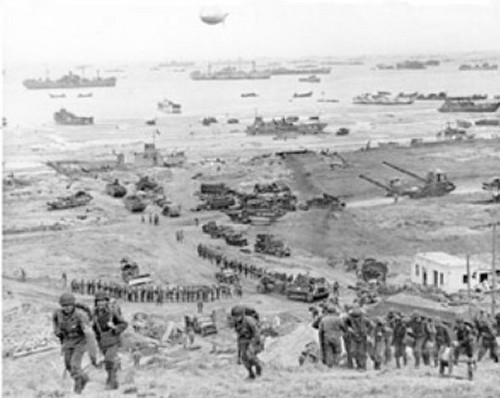
Once WN64 was
disabled, the beach was finally open for the Americans to
rush supplies and reinforcements ashore.
There was
still a lot of fear concerning a Panzer counter-attack, so
no one took any breaks that day. The Americans wasted
no time moving in and establishing control.
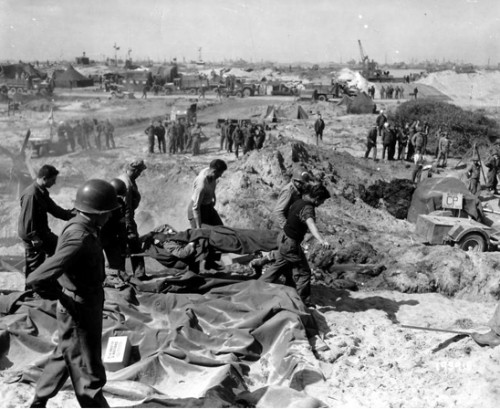
Quickly the Easy
Red sector
became very crowded.
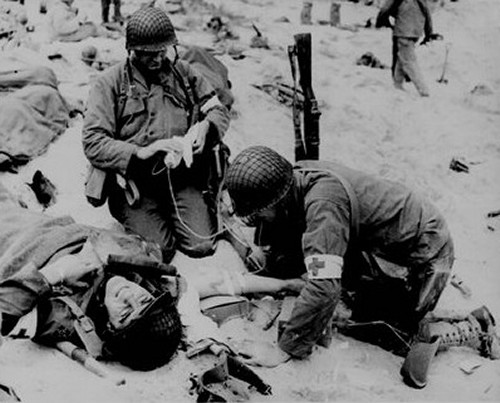
There were plenty
of wounded soldiers to attend to.
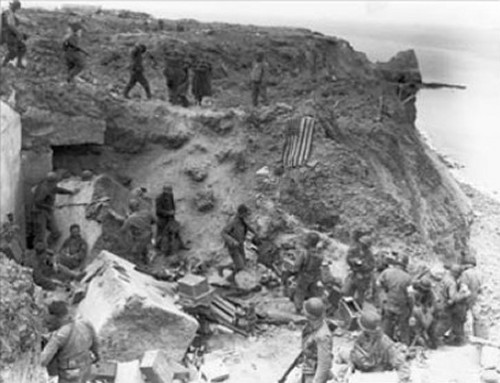
Prisoners of War
from WN64 being escorted down to
the beach
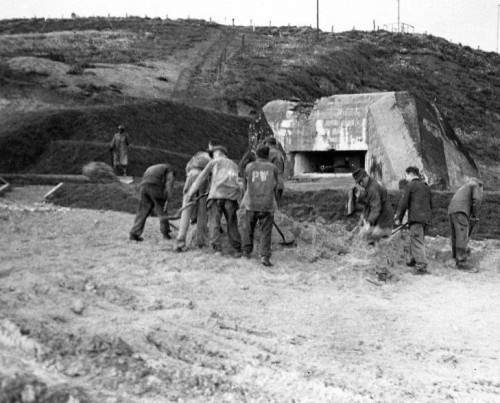
They quickly found
lots of things for the prisoners to do...
like digging up mine fields |
|
|
|
|
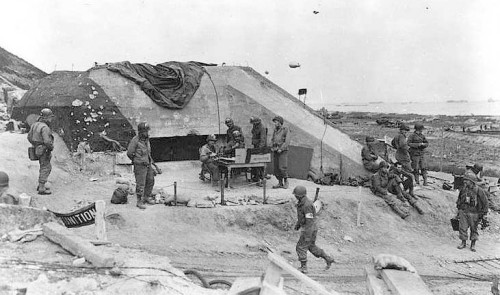
Officers found
interesting places to fill out reports.
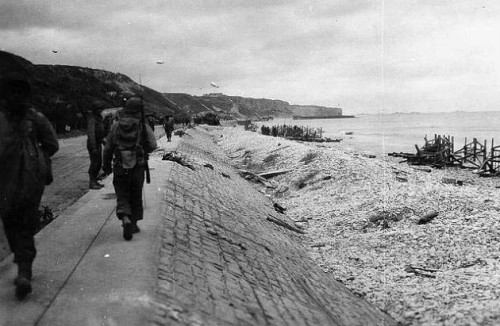
Tight patrols were
quickly established. With all the hidden trenches,
there was always a danger of a sneak attack.
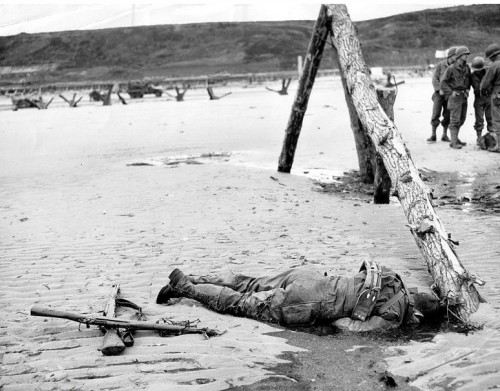
The battle was won,
but it ended tragically for
2,000 Americans.
|
An Amazing
Accomplishment
With the fall of
WN64,
the Breakthrough was complete. Spalding, Streczyk,
Colson and the rest of E Company along
with Dawson and his G Company had created the first major
wedge in the formidable German defense. The
credit for cracking open the vaunted German defense belonged
to both companies. Now that this
area was cleared, they were quickly joined
by reinforcements who were able to systematically attack the
remaining bunkers from all sides.
Spalding, Streczyk and Dawson were awarded
the Distinguished Service Cross. All three men were honored to have
General Eisenhower personally greet them and give them their award.
In his book, Dawson
pointed that 34,000 men landed at Omaha Beach that
day, but a handful of men - 250 on Dawson's part,
20 on Spalding and Streczyk's part - bailed out the entire American
assault force at Omaha.
When the
Americans were stuck on the beach,
it took these three heroes and their
comrades to singlehandedly break the battle open. Dawson
and Spalding apparently worked the opposite sides of the
same ravine. After
marking the mine fields and eliminating
several pockets of resistance on the way up, both crack
units knocked out the remaining defenses at the top of the
hill. In so doing, they saved countless lives of men
who had been pinned down on the beach under withering fire.
While the
battle for
WN64
was going on, right across the Ruquet Valley Draw another
pitched battle was going on for the control of
WN65.
Now
the tide turned. Once
WN64 went down, soon
the other strong
points began to fall like dominos.
Thanks to the heroics of Lt Col George Gibbs
and Sgt Skiba,
WN65
fell an hour after
WN64. At this point, the Americans had
finally secured the precious prize they had sought all day -
control of both sides of a draw.
From this
point, engineers worked furiously to clear out land mines,
bulldoze a road through the shingles and strengthen the
existing road through Ruquet Valley to support armored
tanks. The E-1 Draw was finally open for business.
Suddenly those tanks Rommel feared most began to burst into the French
countryside.
The path that
men like Spalding, Streczyk, Gibbs and Skiba carved out became the
main personnel exit for the entire V corps for the next 48 hours.
These three leaders
and their men had saved the day. At 10 am, General Bradley had
been
convinced the battle was lost. He would have ordered a
retreat if that had been a possibility. Unfortunately,
just as many men would have died in any retreat or rescue attempt,
so he let them fight on.
One hour later at 11
am Bradley received the first news that what had looked like certain
defeat was now turning the other way. American soldiers had been spotted on
the ridge and German fire was mysteriously lessening.
Spalding,
Dawson, and Streczyk were not the only heroes at D-Day, but
a strong case can be made that they made the greatest single
contribution.
As one writer put
it, by creating a safe path out from Omaha beach, these three
men managed to put the first small crack in the fortress of
Nazi Europe.
Now that was quite an accomplishment.
|
|
Chapter Six
-
Reflections
A
look back at the events
of this story
|
|
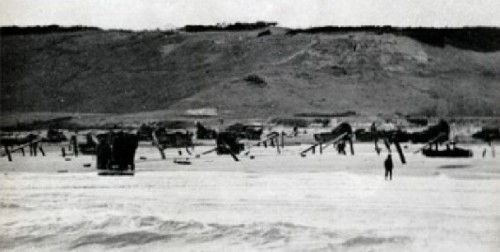 |
|
|